CRITTERS AT or
NEAR BRAZOS BEND STATE PARK--SNAKES non-venomous 4
This page was born 03/02/2013. Rickubis designed
it. (such as it is.) Last update: 07/14/2025
Images and contents on this page copyright ©2002-2024
Richard M. Dashnau
Snakes page 1 nonvenomous 2001 -2002 Snakes page 6 Rat Snakes 2002 - 2021
Snakes page 2 nonvenomous 2003 -2004 Snakes page 7 venomous 2002 -2021
Snakes page 3 nonvenomous 2004 -2006
Snakes
page 5 nonvenomous 2022 -2023
----------------------------------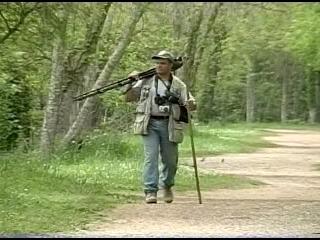
That's me on a trail (03/29/2004). As I get
more pictures, these pages expand. I've gotten enough images of
snakes to collect them on the snake pages. For most of my
identification, I'm using "Texas Snakes-a field guide", by James
R. Dixon and John E. Werler (2000, 2005)
At Scobee Field on 9/25/2021--
inside of Barker Reservoir, I met this Gulf Coast Ribbon Snake
(Thamnophis proximus). For the full story, visit my ichnology page.
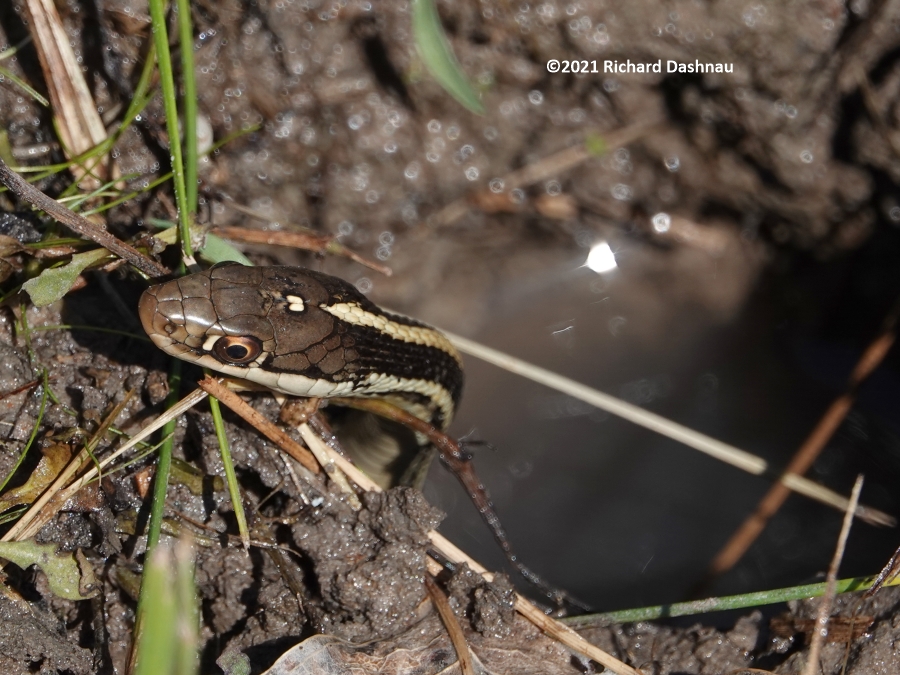
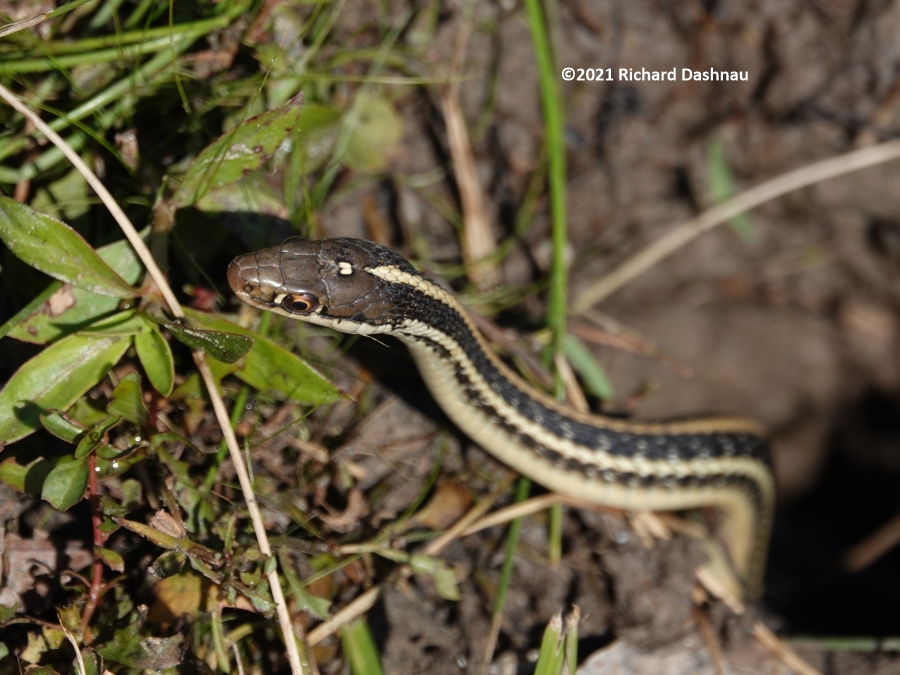
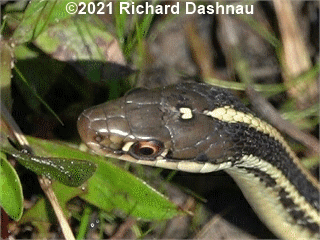
06/05/2021 (posted
6/13/21) I visit Fiorenza Park
frequently . It's pretty close to home, it covers 362 acres, it has
about 6 miles of trails and a wonderful collection of wildlife.
I'd seen a number of interesting animals at the park (documented on
other pages), when a Diamondback Water Snake (Nerodia rhombifer) came
swimming by. I followed it for a while,
trying to film it. Then another one came from the opposite direction, so
I followed that one back towards the bridge. Another one came from
across the channel, and I watched that
one swim towards the bridge and over the sidewalk. There's
also a short
video clip (mp4) showing them moving around.
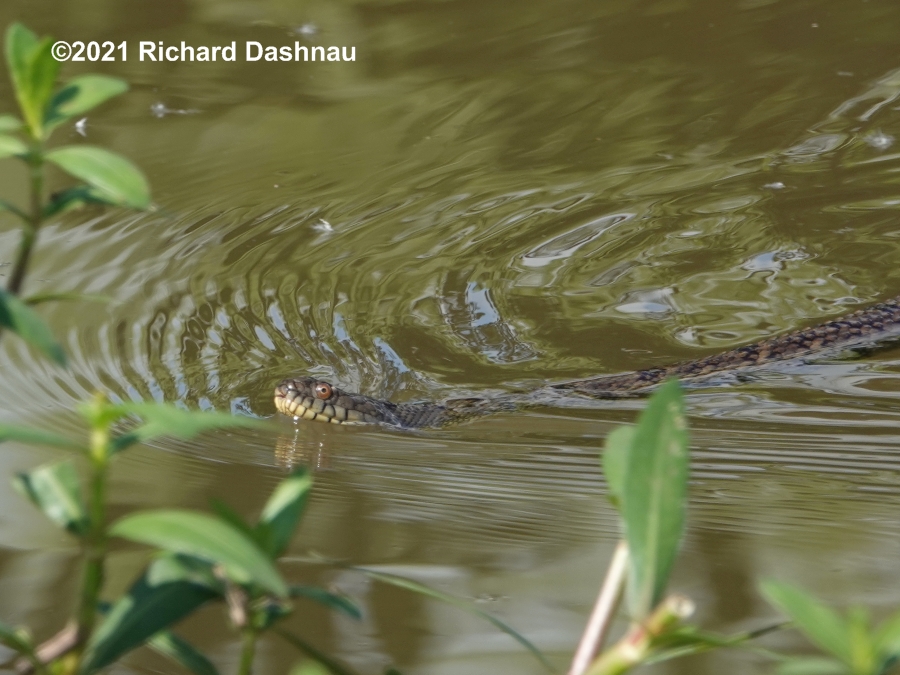
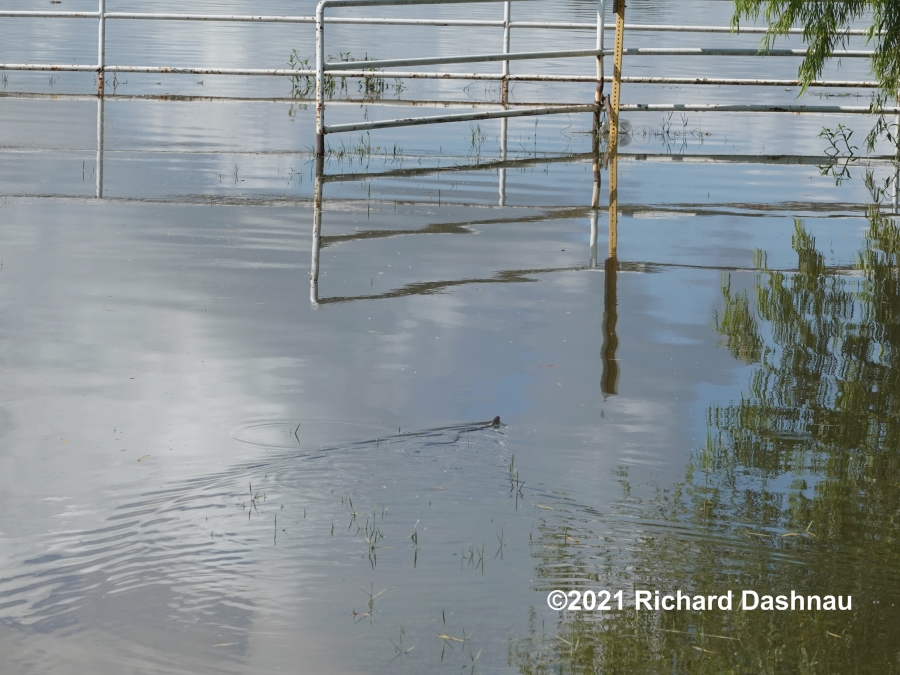
BEAUTIFUL
SWIMMING SNAKE SWIMMING
TOWARDS SUBMERGED BRIDGE
05/02/2021
Even with more "spare time"
it's taking me days to work on new material so I can post it. Part of
the reason is that I get more
new material before I've completed
editing of the previous new material--because I have more of that "spare
time" to go get the new material. Oh, darn. LOL
So, here's how my morning went at Brazos Bend State Park on 05/02/21.
I'd
been staying near an alligator, and paying attention the the alligator,
and park visitors, I didn't look around much further. One of the
visitors noticed a snake nearby, so I went to look. It wasn't moving
and was mostly hidden, but I'm pretty sure it was a Mississippi Green
Water Snake (Nerodia Cyclopion). The general dark-green color, the
keeled scales, and the dark edges on
the scales around the lips (sometimes described as looking like
"threads") help me ID this as a water snake--but the closeup
shows that there's a row of scales between the bottom
edge of its eye, and the lip scales below it. Only
N. Cyclopian has this row of scales.
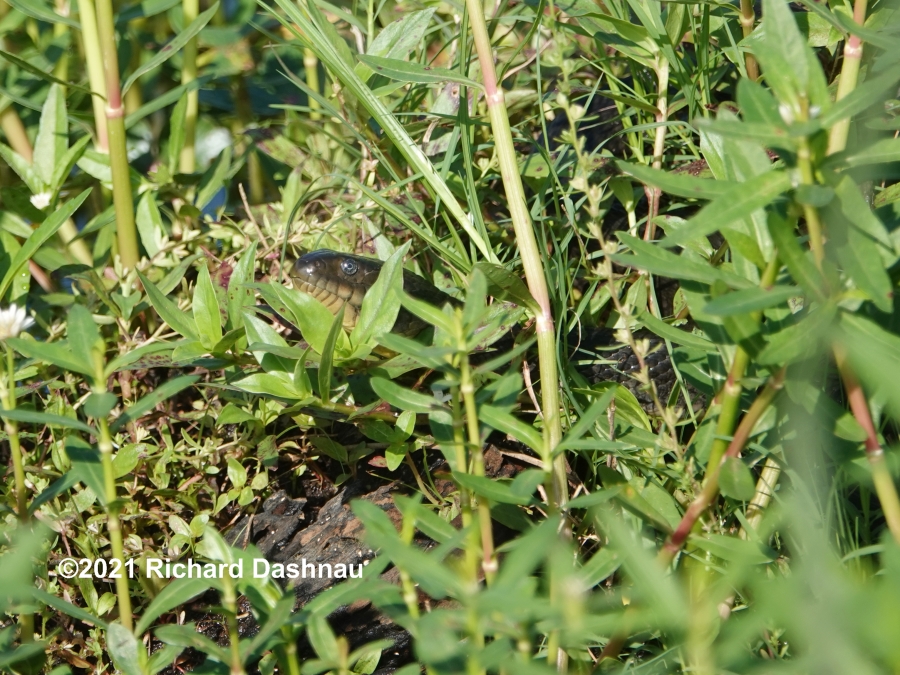
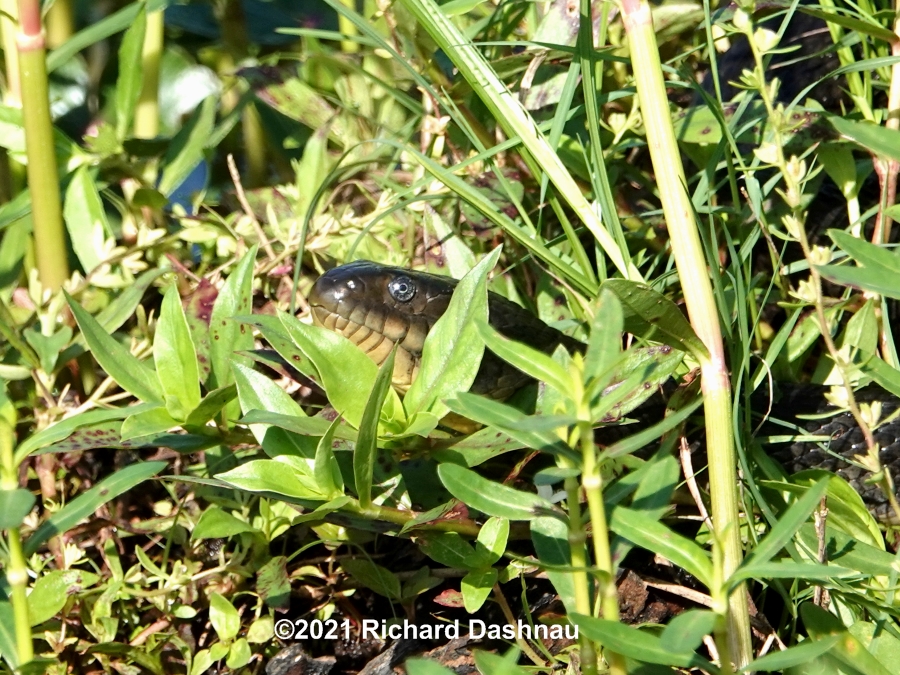
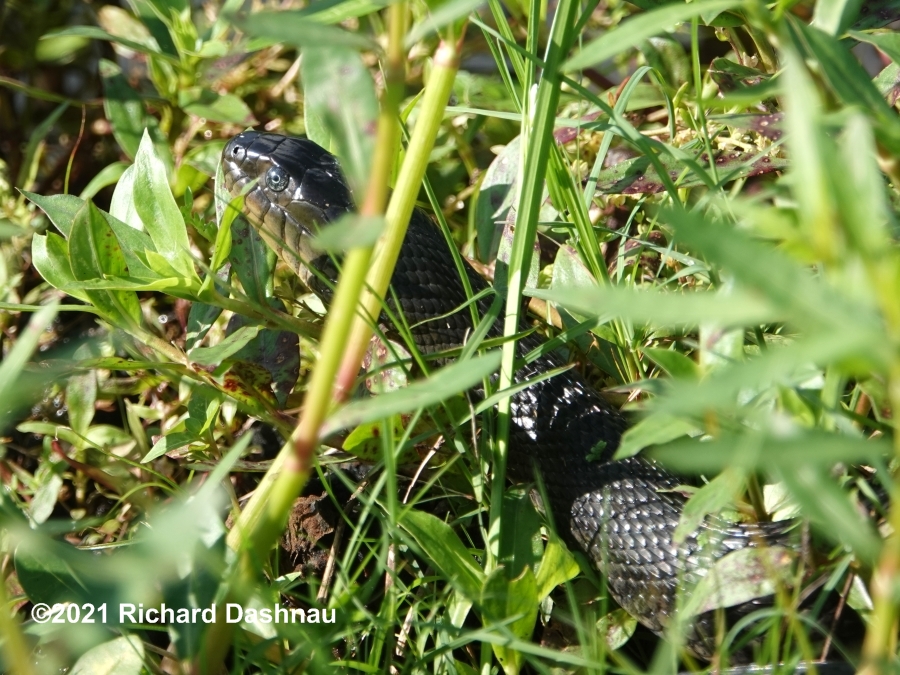
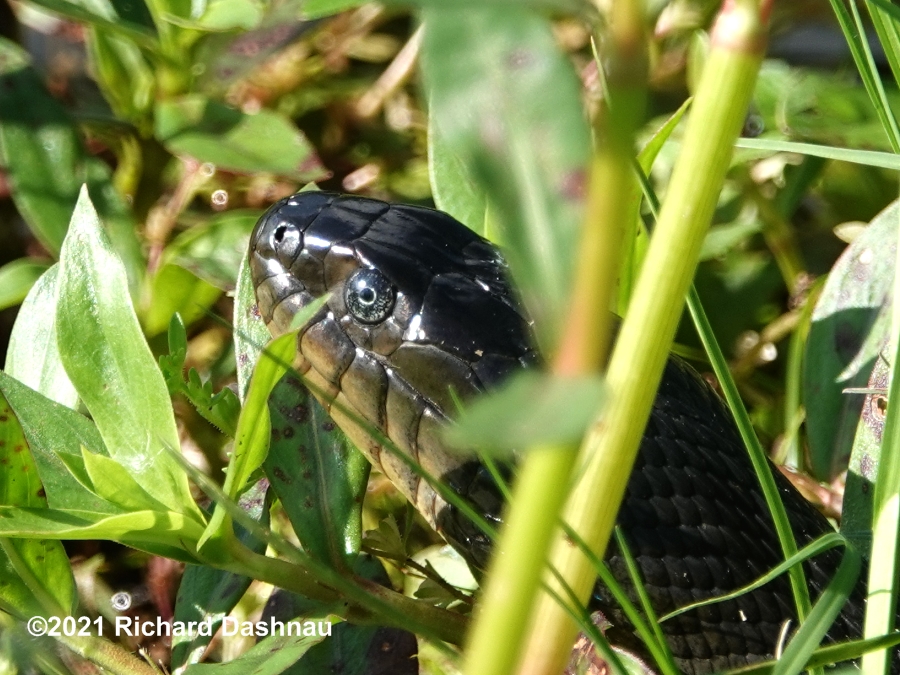
Mississipi Green Water Snake
(Nerodia Cyclopion).
08/13/2020 I
caught a quick look at another Diamondback Watersnake at
Fiorenza park, it's the image below.
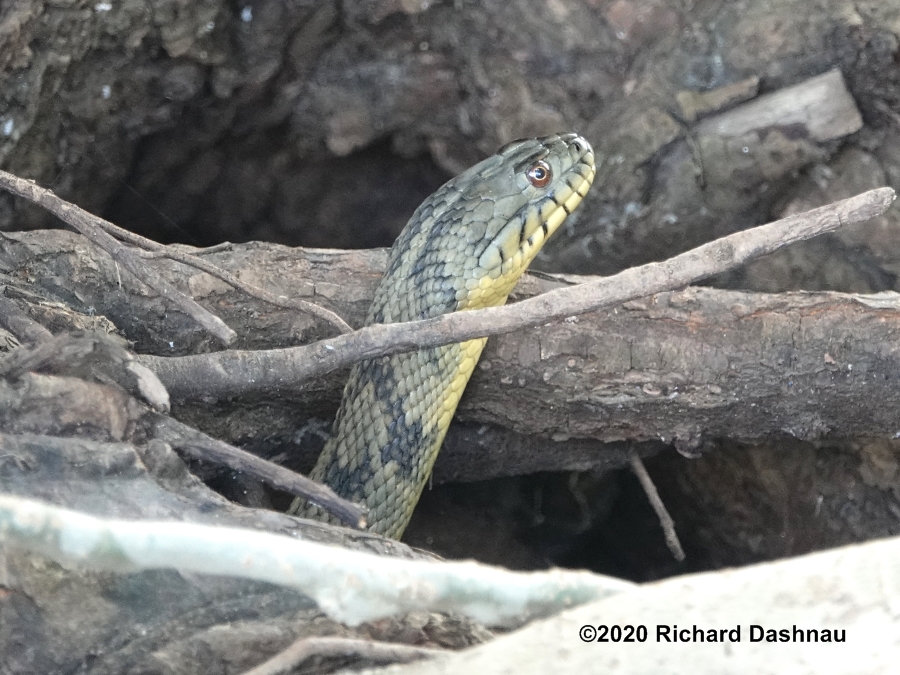
04/25/2020 Like
almost
everyone these days, I've been staying inside. I have
stopped driving around outside
for...recreational purposes. BBSP is just too far away, AND,
entrance protocol
to the park has changed dramatically (even for volunteers).
So...I haven't been going there. The parks in the city are
generally pretty crowded (when they are open) so I've been
staying away
from them, too. Still, it is possible to have a quiet walk
anyway. For instance, this morning, just before sunrise, I
took Piper for a walk.
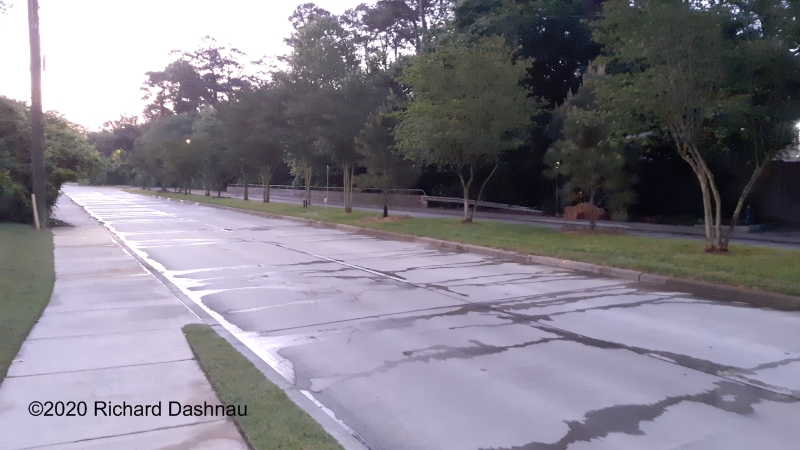
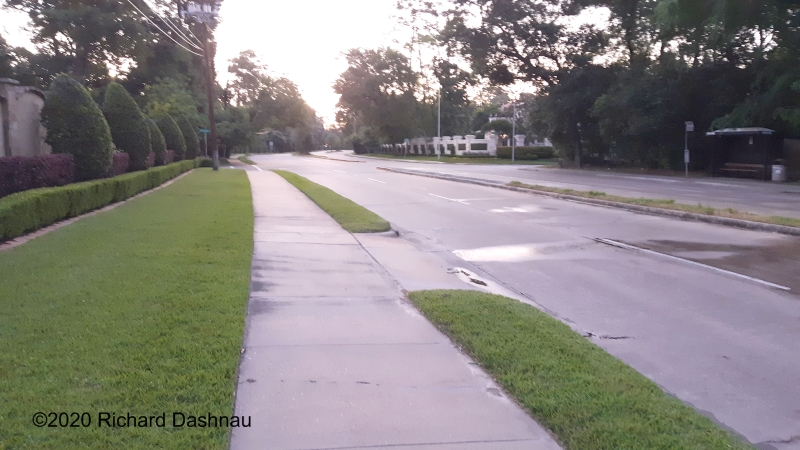
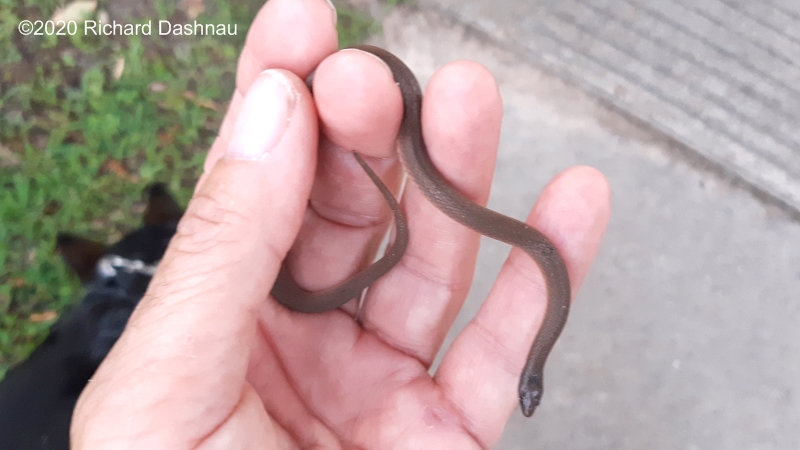
The
first
2 pictures are the street that I walk along. Near the point
where I turn around to come back, I found a snake on the
sidewalk. It was about 69 deg. F, and the snake was a bit
slow.
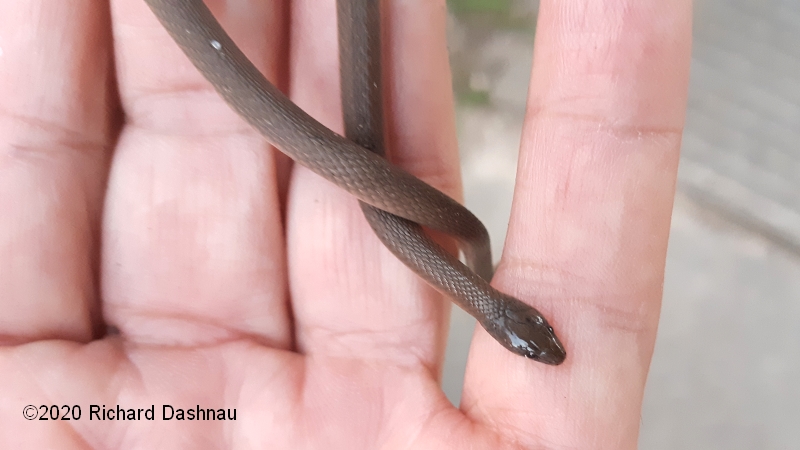
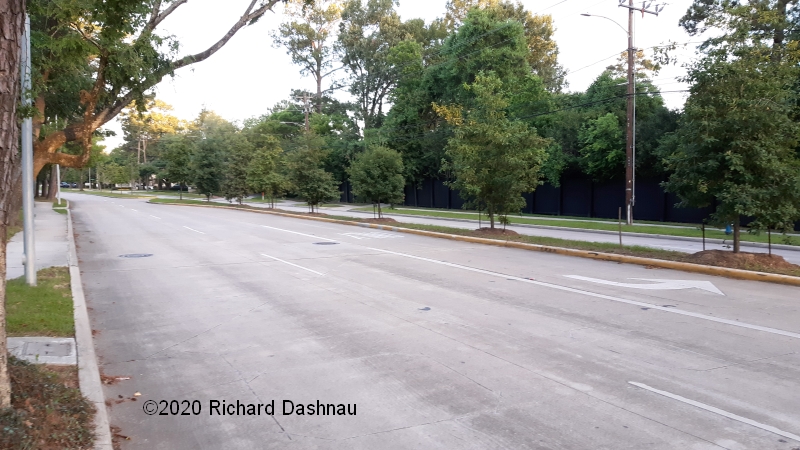
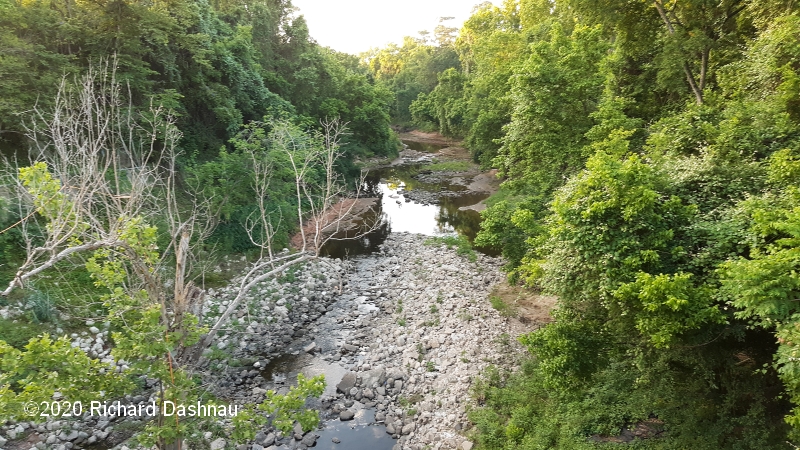
I
released
it into a nearby garden. Walked back along this road. Then a
little further along-if one stops at the right spot and then
turns in the right direction,-one can see the view I show
in the last picture. I can't go in there (and hopefully
not many people can), but it's a great sight! Snake
is brown, with keeled scales & pointed snout,should be a
Rough Earth Snake
(Virginia striatula). (I
used Texas Snakes by Dixon and Werler to I.D. the snake.)
02/15/2020 While
visiting Archbishop Fiorenza Park (Phase II) I saw a few
Diamondback Watersnakes (Nerodia rhombifer). The water
here is often pretty murky, so once anything
submerges, that's it. I usually don't see it again. The
dark lines (sort of forming diamonds on the back) against the
light grey background are good for identifying these.
They're the first and
second images below.
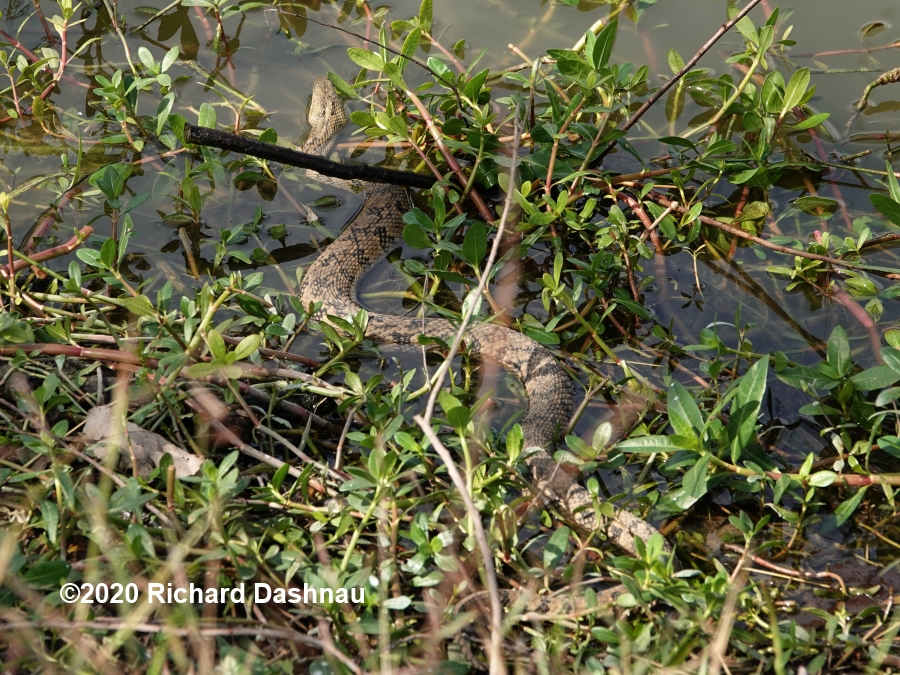
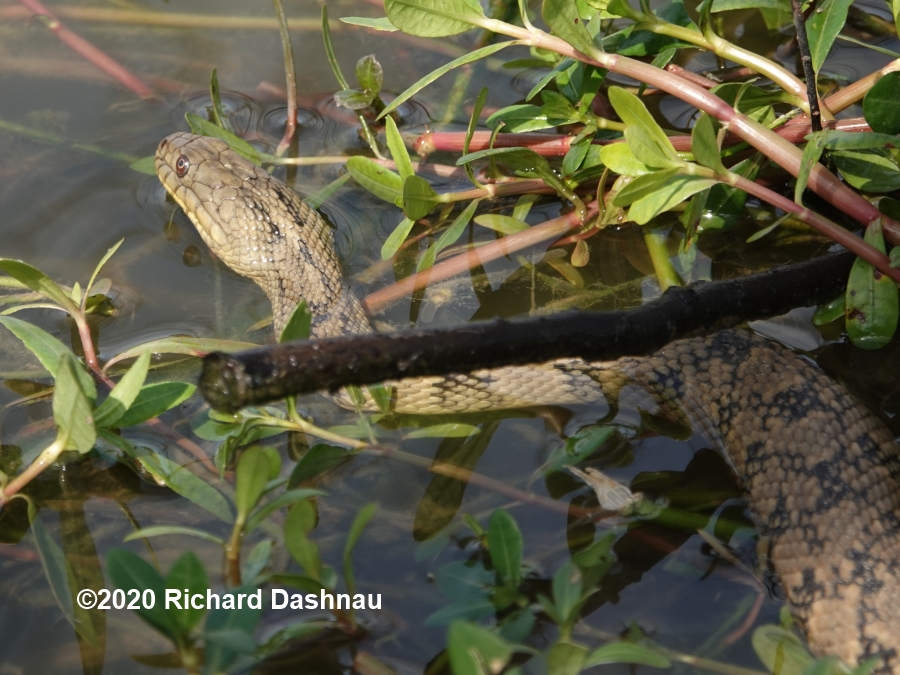
05/13/2017 At
Archbishop Fiorenza Park (phase II), I saw this Diamonback
Watersnake hunting and basking near the low bridge. Rough,
keeled scales, light grey color with dark markings
that make a diamond pattern down the middle of the back (and
lines on the scales around the mouth); reddish eyes with round
pupils, the back of the head is close to the size of the
neck
when the snake is relaxed--all these features togethe can help
identify this snake (Nerodia rhombifer).
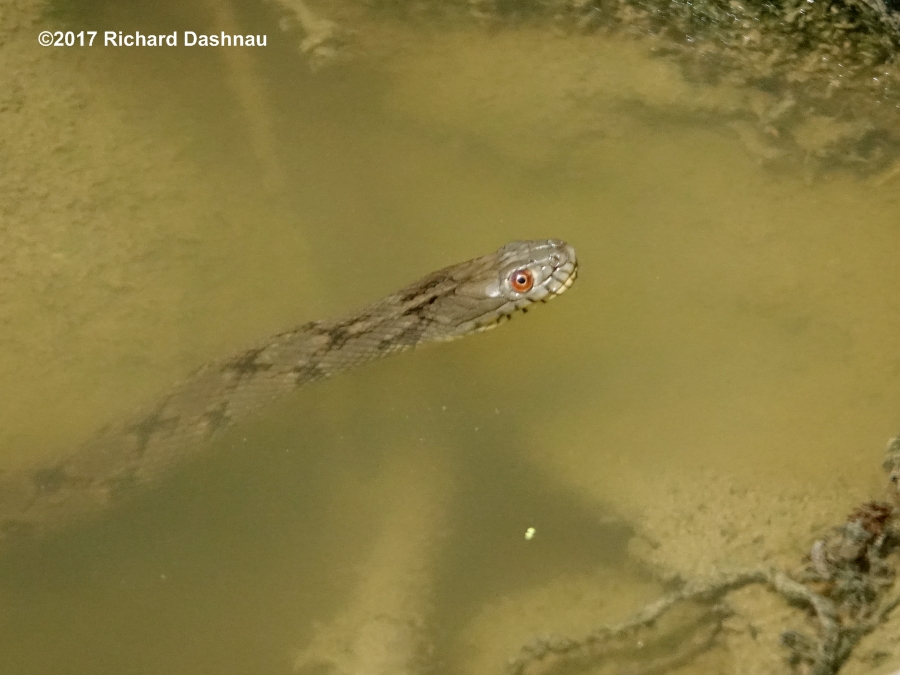
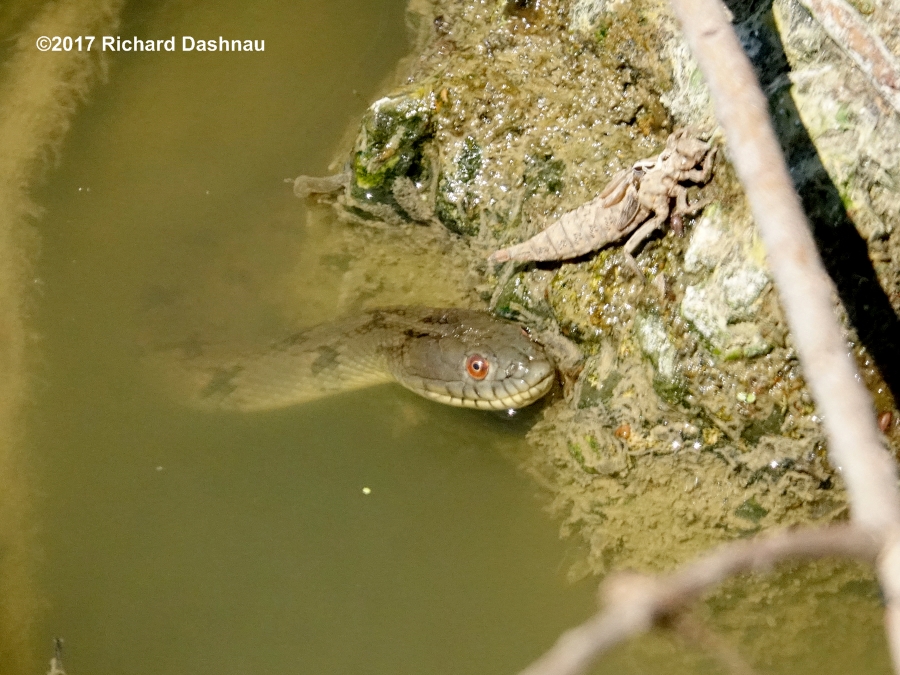
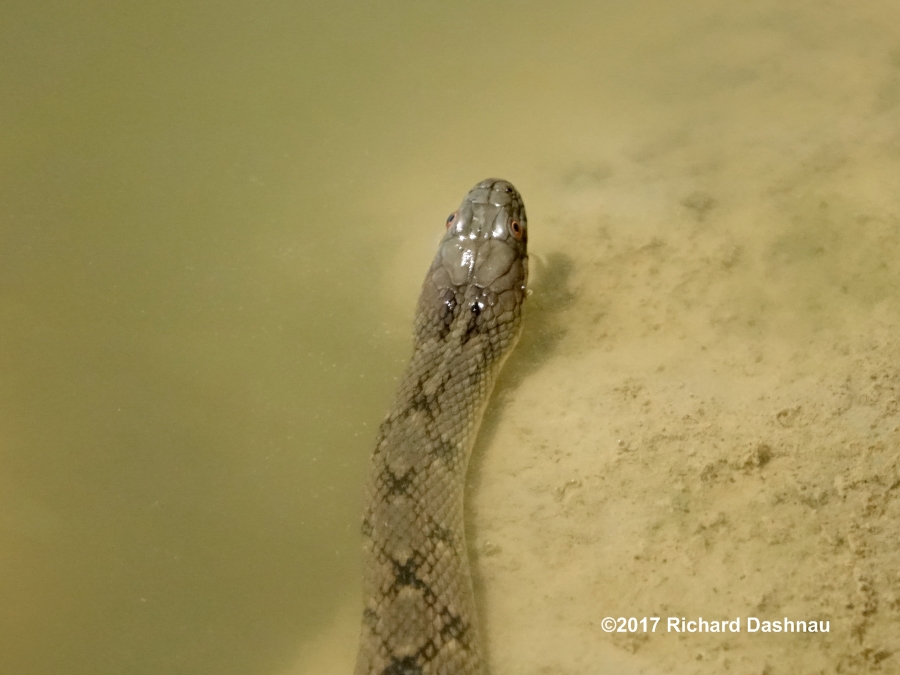
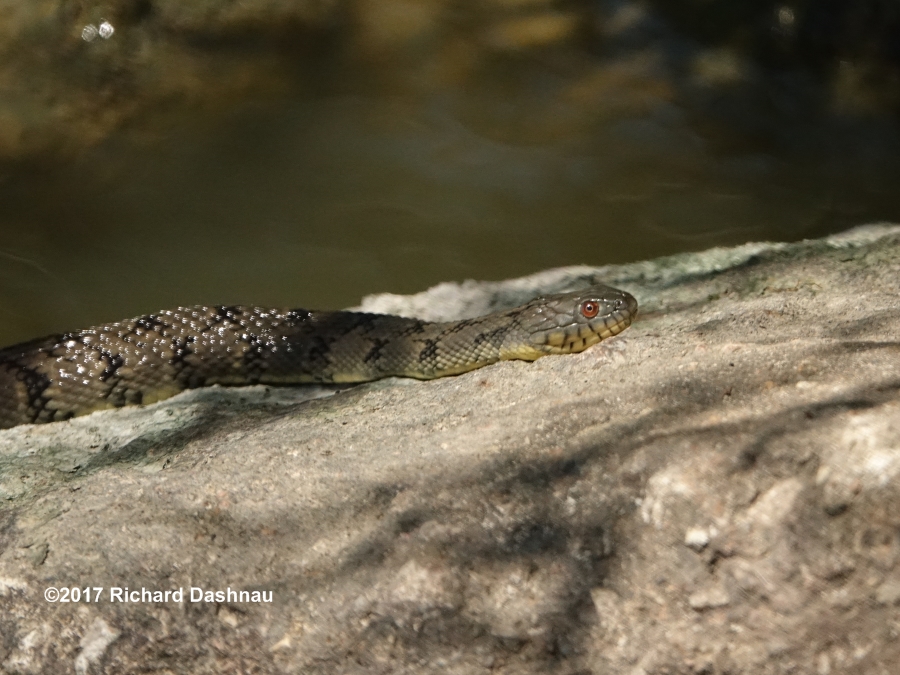
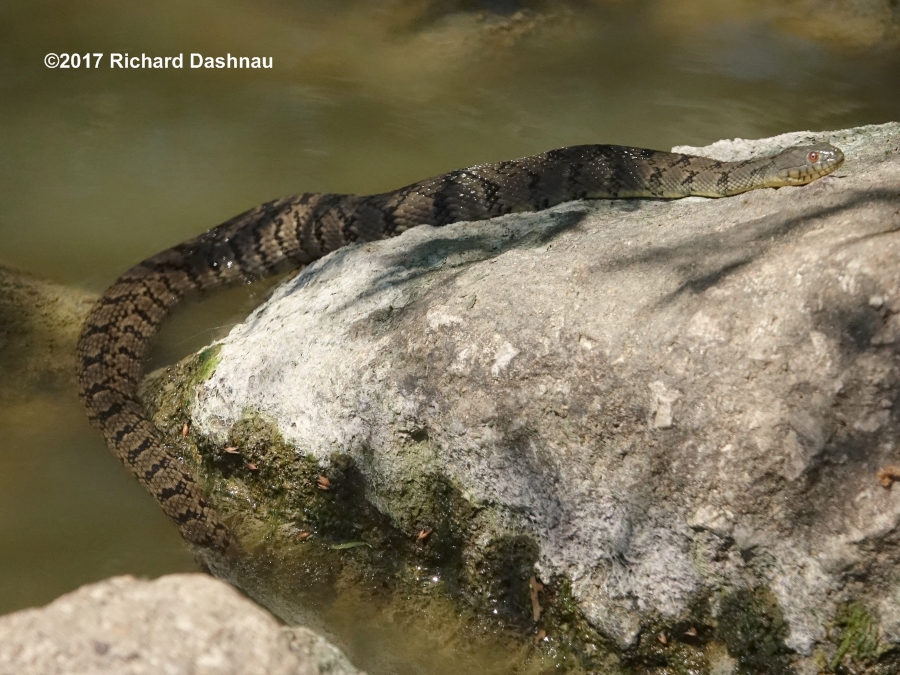
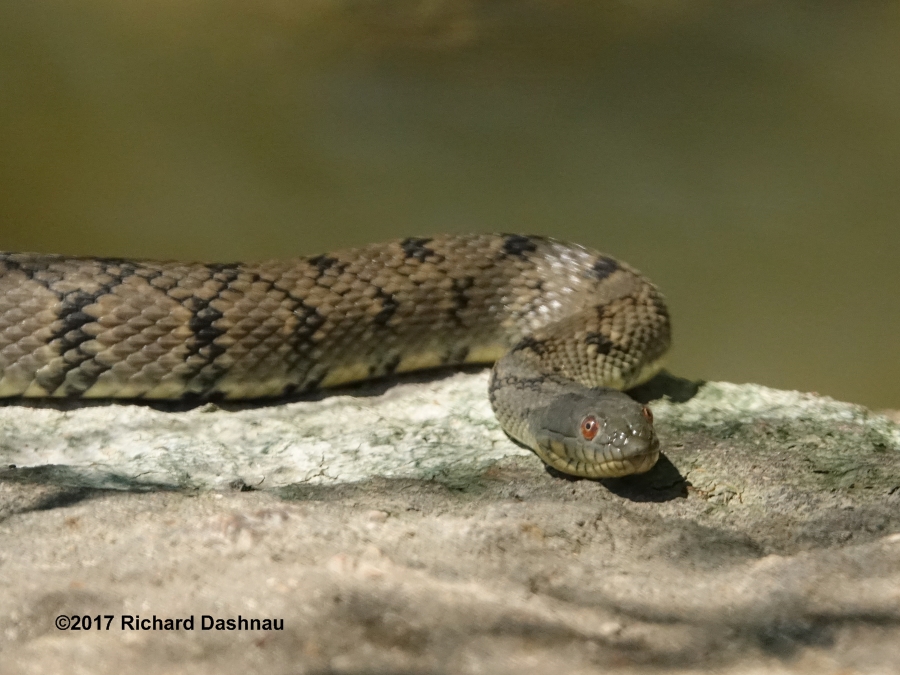
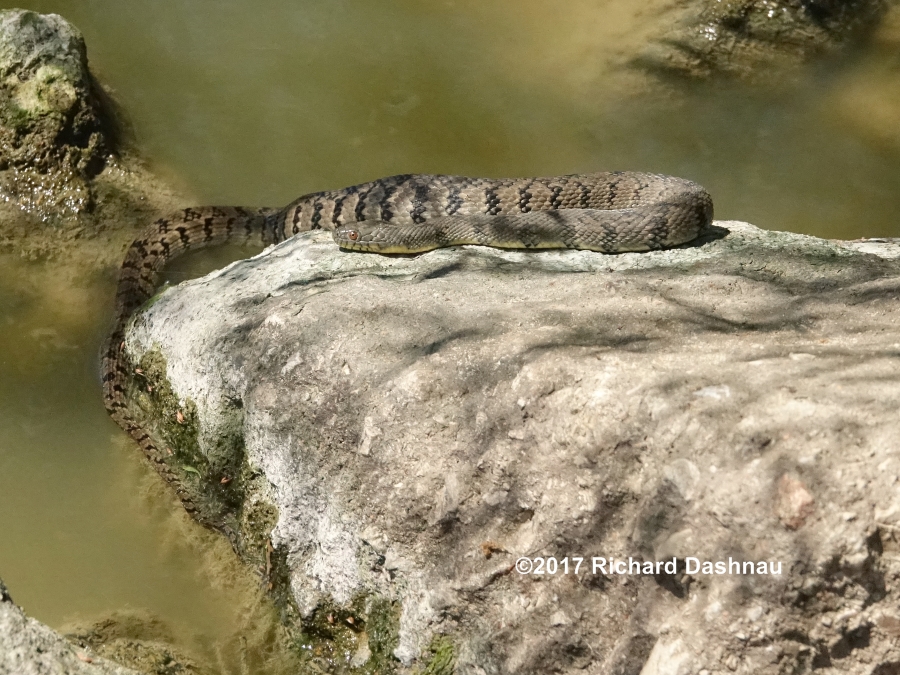
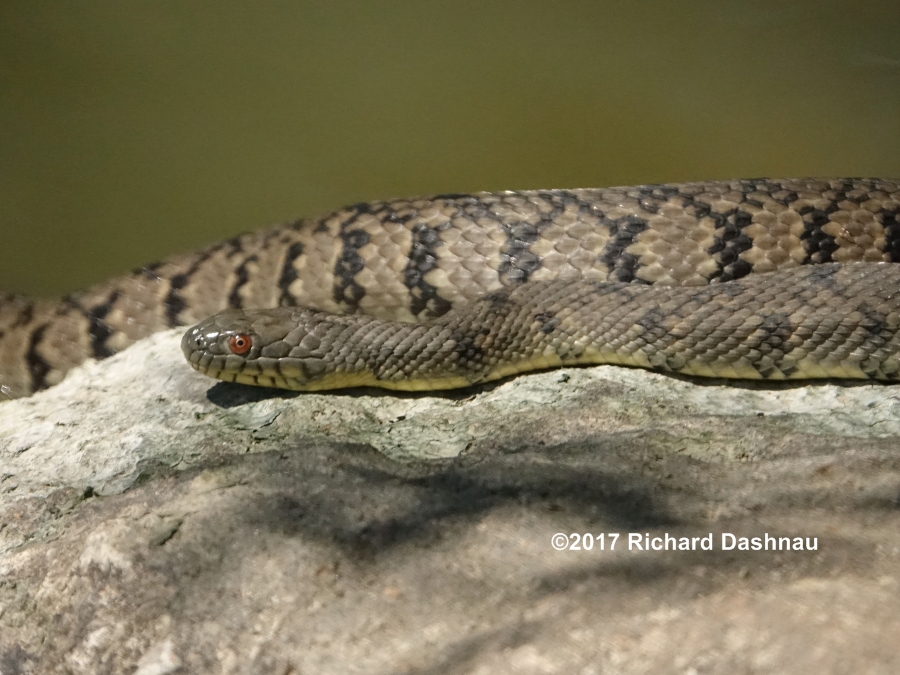
04/16/2017 Easter
Sunday is usually busy at Brazos Bend State Park. So, I usually
bring my bicycle to allow me to cover more of the trails. Today
I rode about 16 miles,
repeating loops over the Elm Lake, Spillway, Pilant Slough, Live
Oak, and 40 Acre Lake trails. I was riding West on the Spillway
Trail when a couple of park visitors called my
attention to a Barred Owl in a tree above the trail. Further
description is on my Owl Page.
Soon
after, I noticed some park visitors looking at something at the
edge of the trail about 20 paces East. When I went there, I saw
a beautiful Broadbanded Water Snake
in a high periscope position. I explained that the snake was
raising its head above the ground cover to see what what around
it, and that it probably intended to cross the trail. The snake
lowered itself into the cover, and appeared again next to the
trail as a shorter periscope. And then...it crossed. This video shows the snake moving across
the trail. Notice how the markings
on the snakes face cross the jawline, and the orange, black, red
and brown coloration. These markings clearly identify this snake
and differentiate it from any of the 3 venomous snakes
that might be encountered at the park.
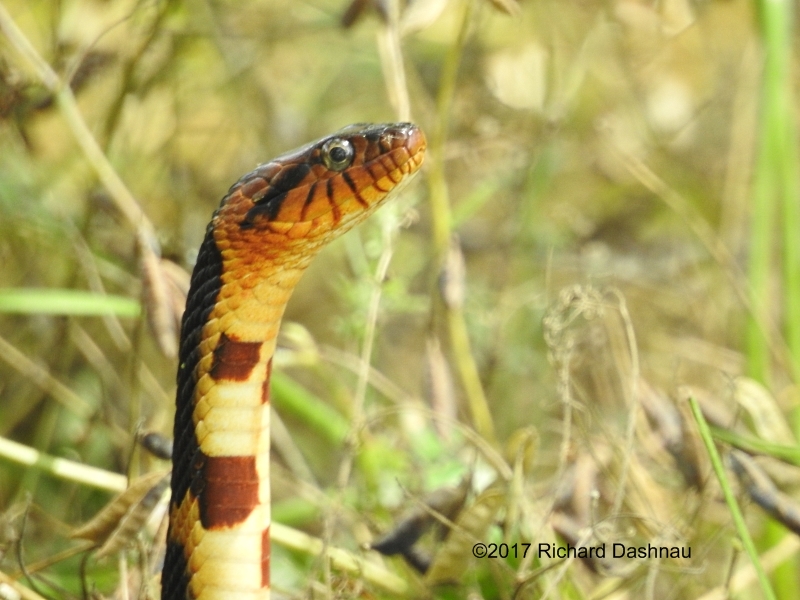
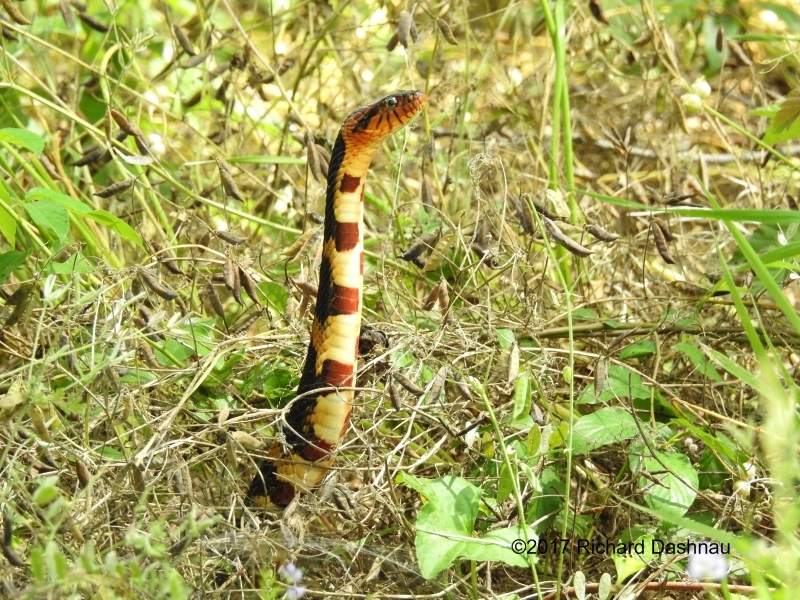
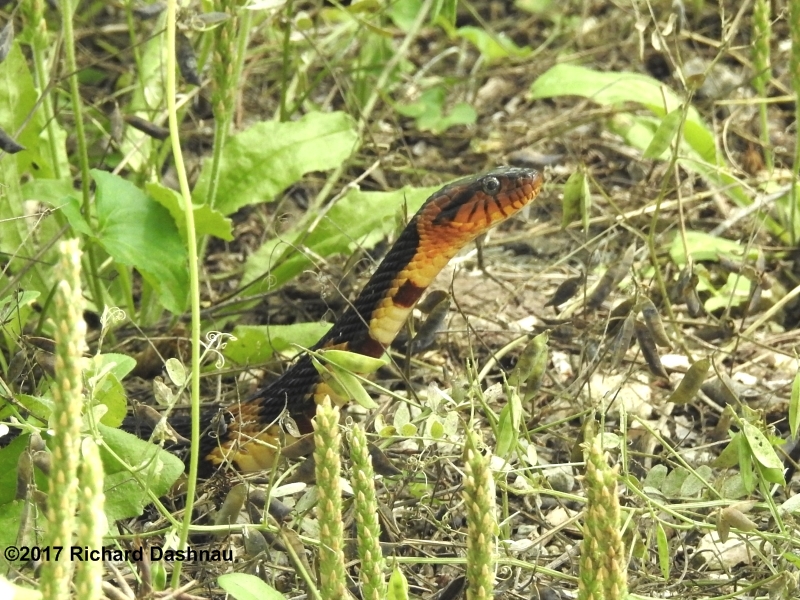
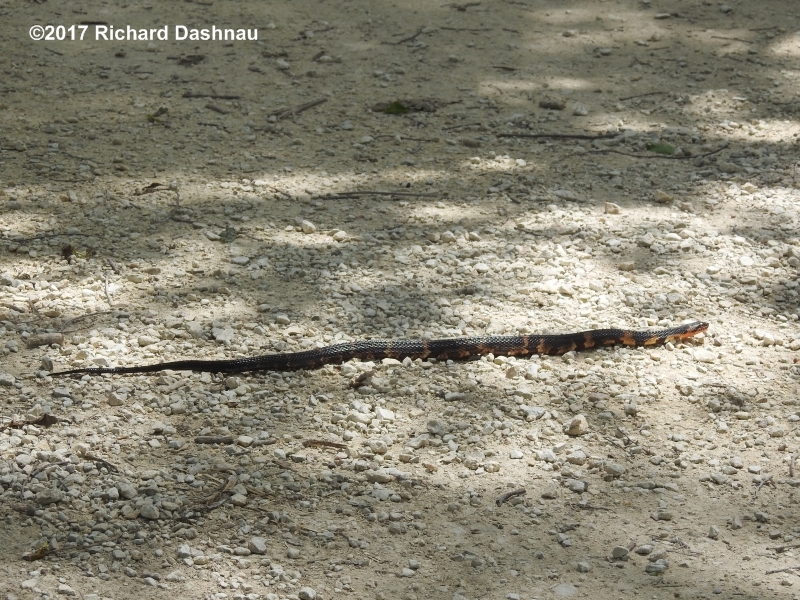
03/27/2016 I
was riding my bicycle towards Elm Lake when I passed a snake on the trail. When it didn't move as I
rode by, I assumed that it might be dead or wounded--perhaps
run over by a bicycle earlier. So I turned around and went back to
the snake. It was a nice speciman of a Broadbanded Water Snake
(one of our prettiest snakes). Water snakes in
general do not take kindly to being handled, and will often strike
at hands put near them. So, I was careful as I approached the
snake. I gently prodded it with a small twig, and it
moved, and flicked its tongue. So, I decided to try to pick it up.
I just slid my hand under it, and lifted it on my palm. The snake
rested there until it seemed to warm up, and began
moving around. So I released it. It was a bit cool this morning,
but I didn't think it was chilly enough to cause the snake to be
torpid. I any case, it moved off into the grass.
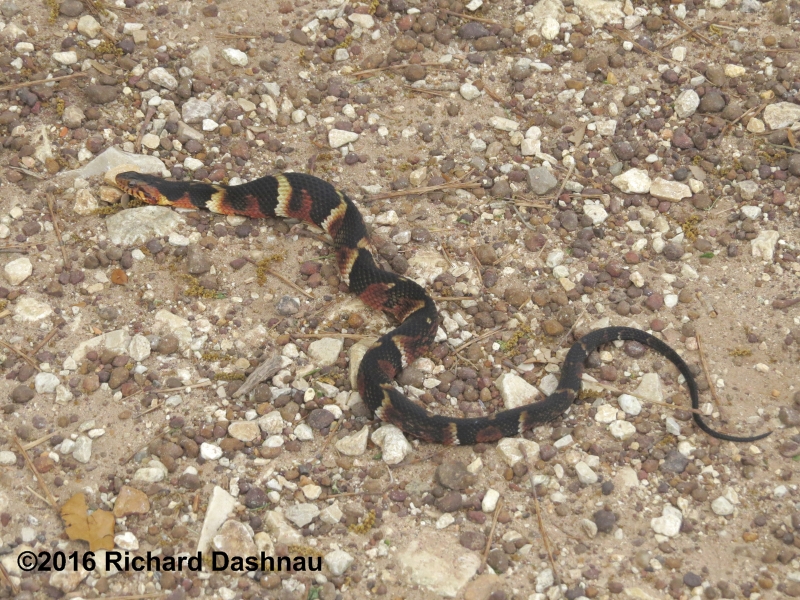
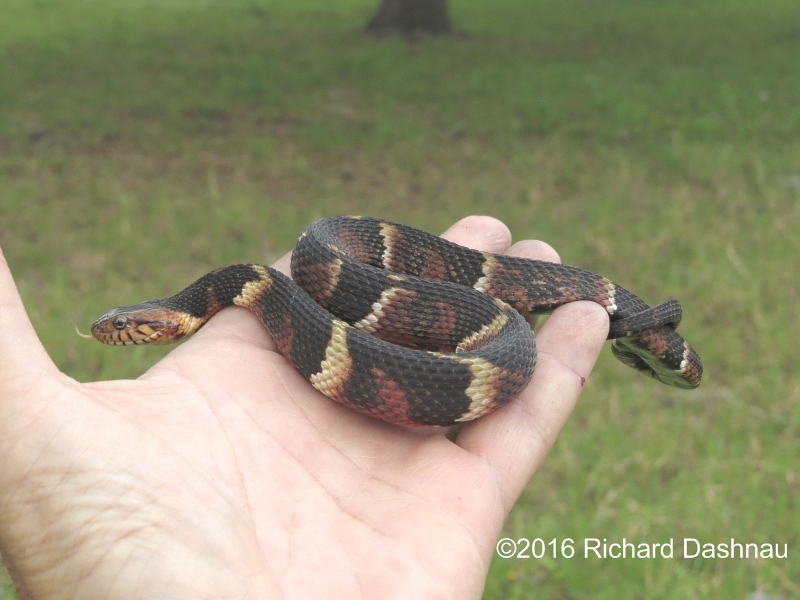
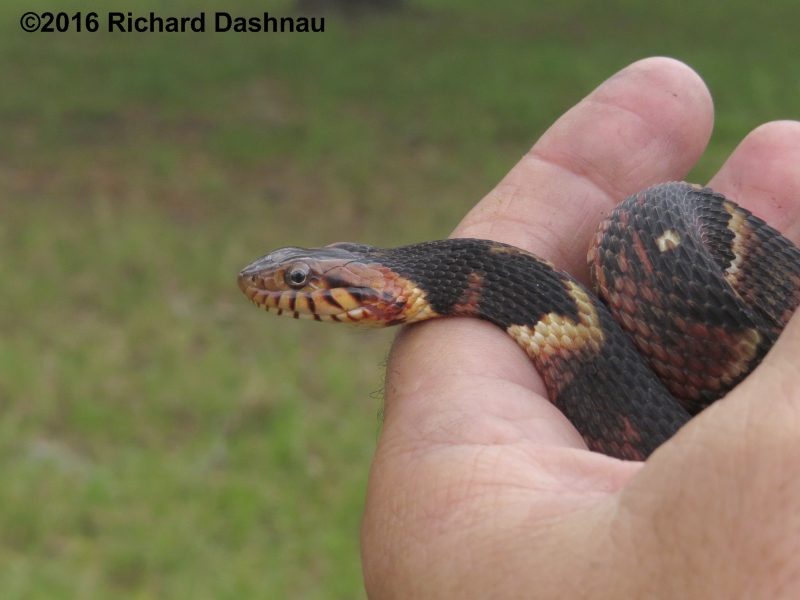
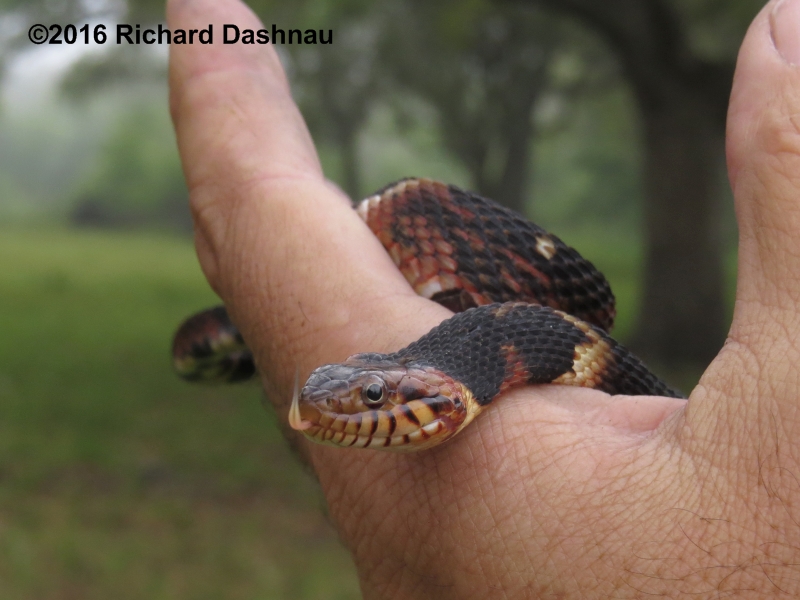
11/25/2015 It was cold this
morning-about 42° F when I got to the park-but sunny. As the day
progressed, it did start to warm. At about 11 am, I heard the soft
call of a frog
in distress, and I looked for it. I knew that I have a relatively
short time to find the frog (and usually, the snake that has it)
before the frog is gone. I got lucky
and found the snake. It was hidden in the grass, but I was able to
find the snake. It was well hidden by the grass, and I
stayed back enough to avoid disturbing the snake
(this was about 8 feet away). Through manipulation of the camera,
and some luck, I was able to get focussed on the snake, and filmed
what I could through a small gap in the
cover. Images below are frame grabs from the video clips. I have
edited the clips together and the result can be seen here. This is probably another Gulf
Coast Ribbon Snake.
Ribbon Snakes are non-venomous, and are not constrictors.
Therefore, they have no way to quickly immobilize their prey-so
they have to struggle with it once it's been caught.
They seem to snag frogs by a back leg--probably because the frog
leaps as the snake strikes. The snake's hooklike teeth take hold,
and then it works the jaws and teeth to work
the prey into its mouth (or to work the snake over the prey). It
can still happen fairly quickly, unless the frog is large,
relative to the snake's head. Then it can be an extended
tug-of-war, but the snake seems to usually be successful. I have
not found any information on why
the frog makes the sound when it has been seized. Perhaps it's
trying to
get the attention of a larger predator--which could eat the snake.
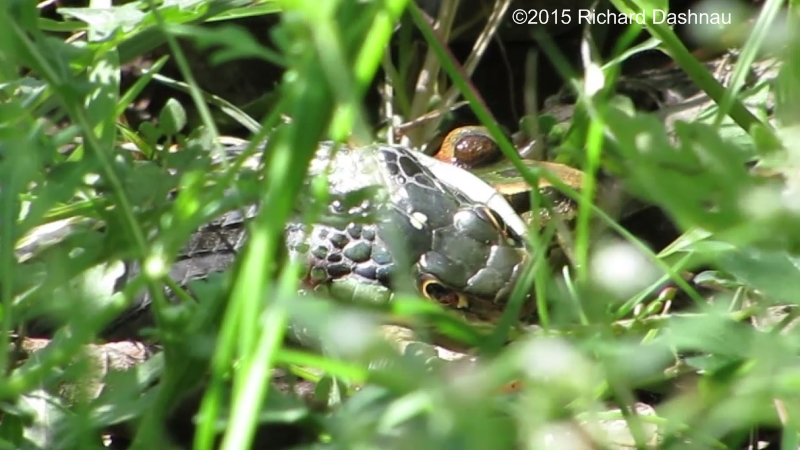
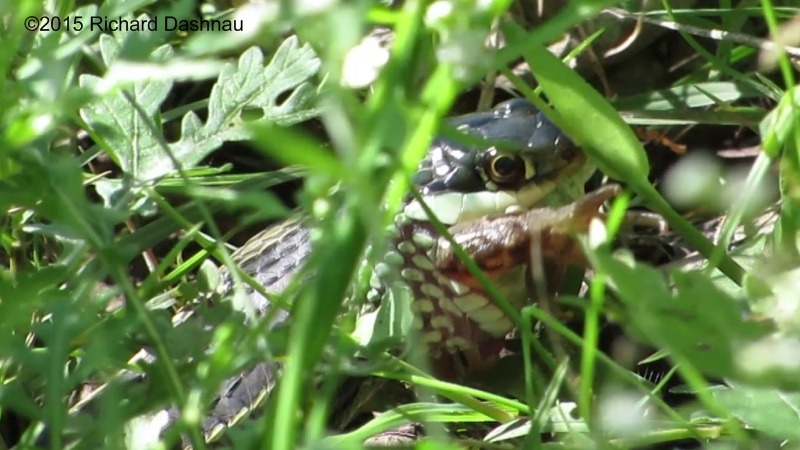
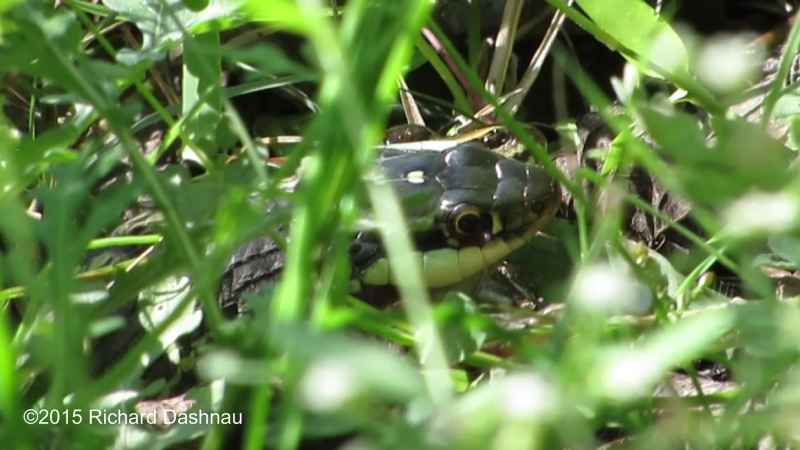
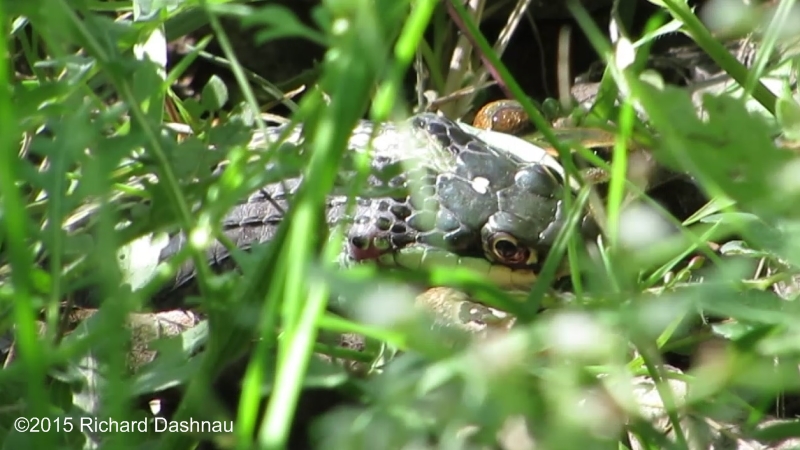
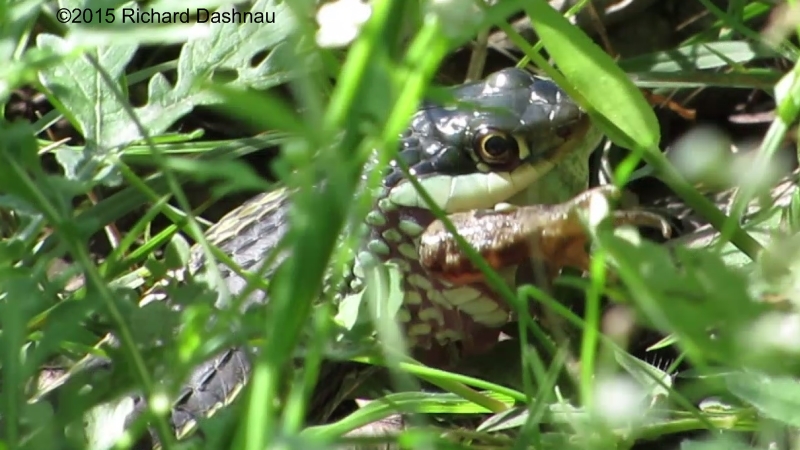
I was suprised to see a snake moving around in such cool
weather--especially one that was hunting! The ground where
the snake was hidden was
tilted towards the sun
and had been getting warmer, but the air temperature was still
probably around 50° F. In the book How Snakes Work by Harvey
B. Lillywhite, it says that snakes generally
"prefer" a body temperature of 29° - 34° C (page 109). That's
84.2° - 93.2° F; and quite a bit warmer than it was this morning.
In the same book, it refers to a behavior
called "acclimatization" in reptiles. This is a tendency for the
"preferred body temperature" to shift (within limits) if the
average environmental temperature has changed
to a higher or lower range for a period of time (i.e. seasonally).
This means that the snake make actually be able to function
properly at lower temperatures than normal due
to changes in body chemistry. In the case here, we had just
experienced a cold front which had dropped the temperature at
least 20 degrees, but it was a relatively short-term
event. Within a few days, temperature had returned to 60's-70's.
BUT...we are in the fall season, so the snakes may
acclimatize regardless.
Here's what I what I was wearing that day, because it was cold
(below left).
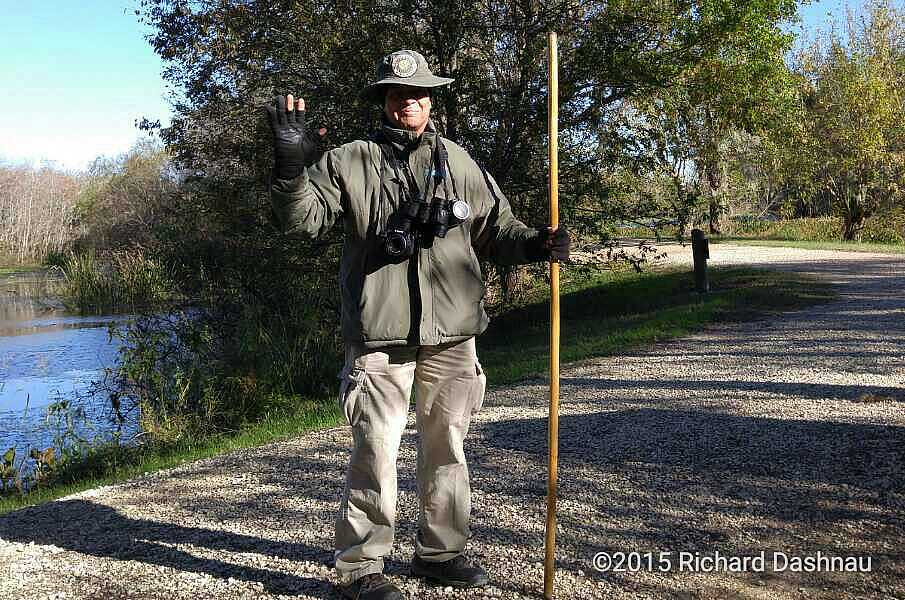
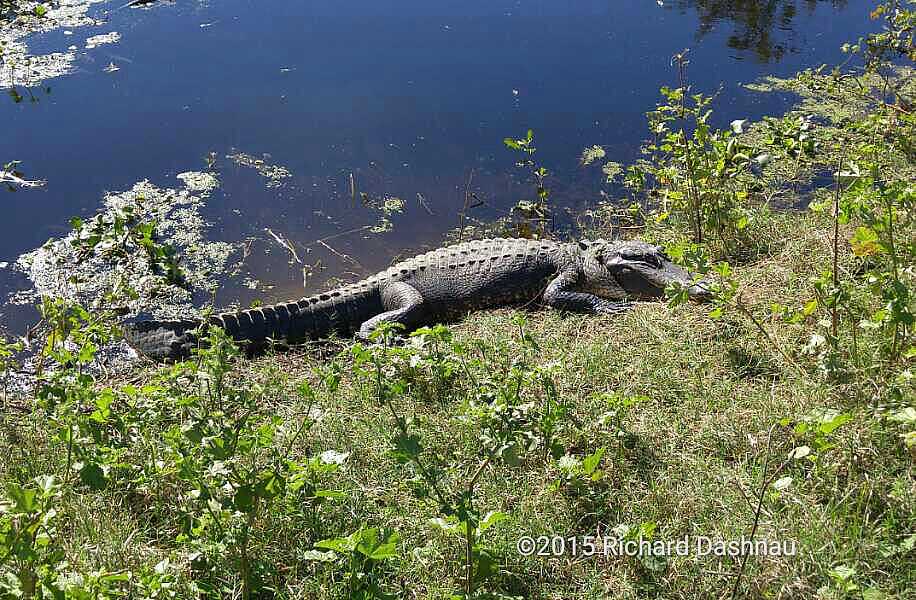
And near Noon, smaller
alligators (generally 3 - 6 feet) came out of the water, like this
5-footer. This is discussed in Biology and Evolution of
Crocodylians, by Grigg and
Kirshner. I'm still working my way through the section on
thermoregulation, but I can see that it is not a simple matter for
alligators. Many factors influence whether or not
a particular alligator will come out of the water to bask. In
fact, the connection between basking and thermoregulation is not
clear--especially for larger animals.
Above some size, body mass allows the crocodilian to maintain a
very stable "thermal inertia"--which means that the internal
temperature changes very little over the course
of 24 hours. Generally, smaller animals (say less than 5' long)
warm faster (and can't hold their breath as long either, but
that's another issue) and cool faster than larger
animals. Depth of the water is probably a factor, too--deeper
water isn't going to cool as fast as shallower water. So, along
the section of trail where I was, the average
water depth may be about 4', and the smaller gators came out
to try to warm themselves. Not many did, but I didn't see any larger ones come
out of the water at all in that area;
although a showed their heads at the surface.
12/14/2014
Not Snakes
and Ladders-Snakes and 'Gators!! On this Sunday, I spent a few
hours by the mother alligator and her babies.
Clouds began covering the sky about 12, so I packed up my scope and moved
to 40 Acre Lake. Near the South end of the East part of the trail, an
alligator was up on the bank. I stayed near
it for a while, to talk to any park visitors that came by. I saw a group
of people moving towards me, so I moved to the side of the trail across
from the alligator. While I was moving off the trail,
I looked down at the leaves...and noticed black scales glistening in the
shadows. I carefully brushed some of the leaves away, and revealed a
beautiful Mud Snake.
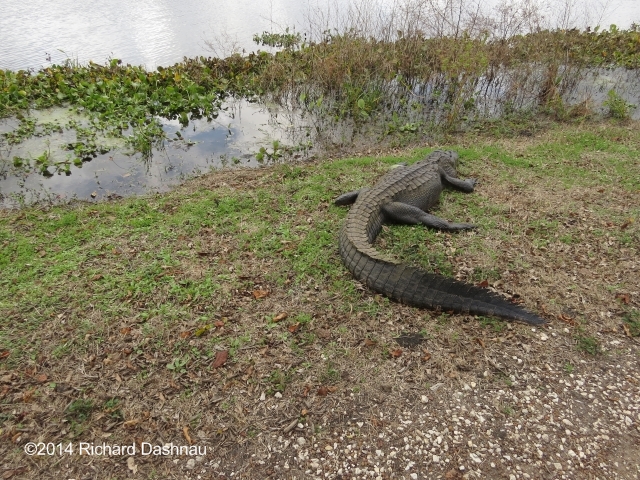
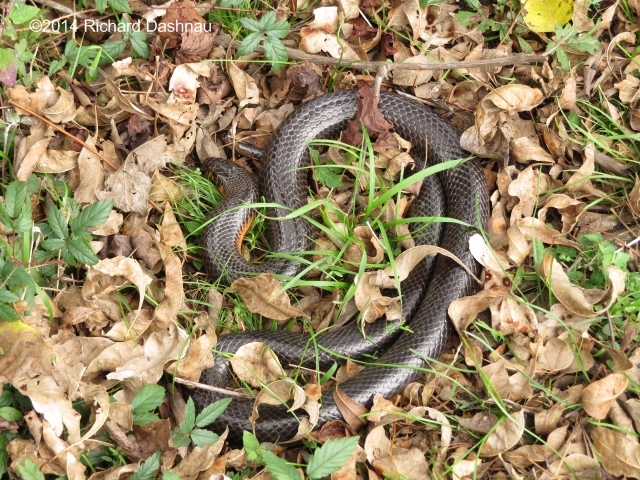
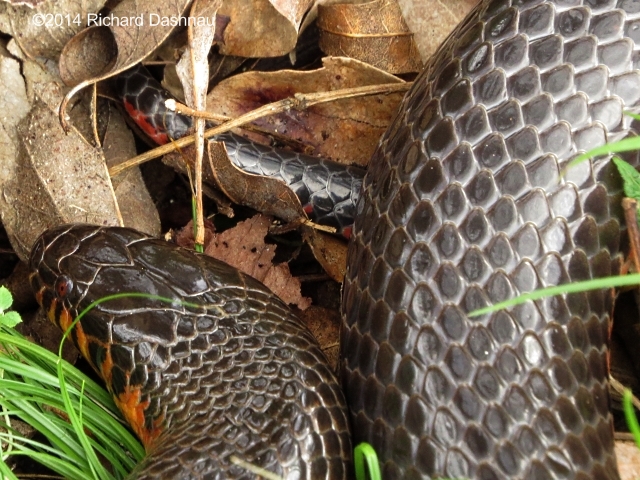
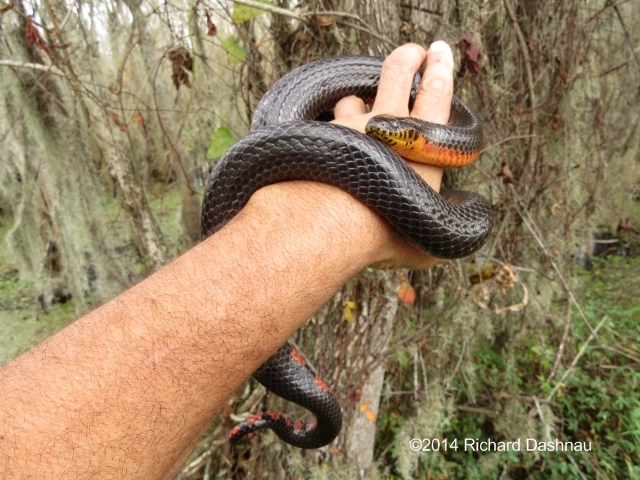
Since the snake was just off the trail, and directly across from the
alligator, I stood very close to it, so noone who was avoiding the
alligator would step on the snake. Although they were
interested in the alligator, but when I pointed out the snake hidden the
grass near me (it was about 3 feet long) they decided it was time to move
on. When the group left, I decided I'd better
move the snake a litte further off the trail, so no one would step on it.
I gently picked it up, and used the opportunity to take some pictures of
it. The snake was very calm an cooperative. The
shiny, "black" scales at the top, and the bright red underside are easy
identifiers for the Mud Snake. After a few pictures, I placed it
closer to the Pilant Slough overflow, and moved back a few
steps to give it space.
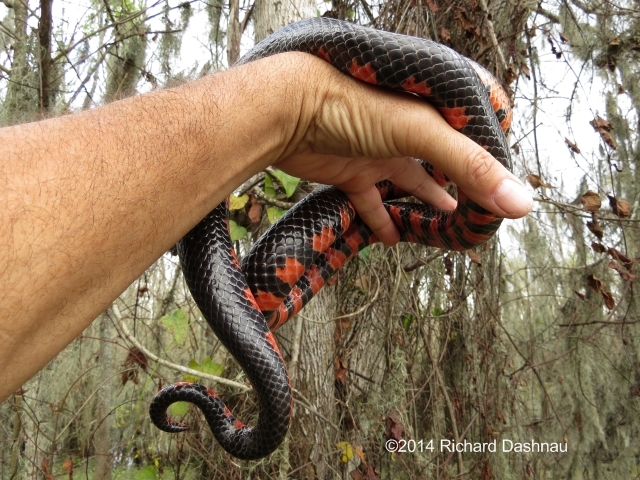
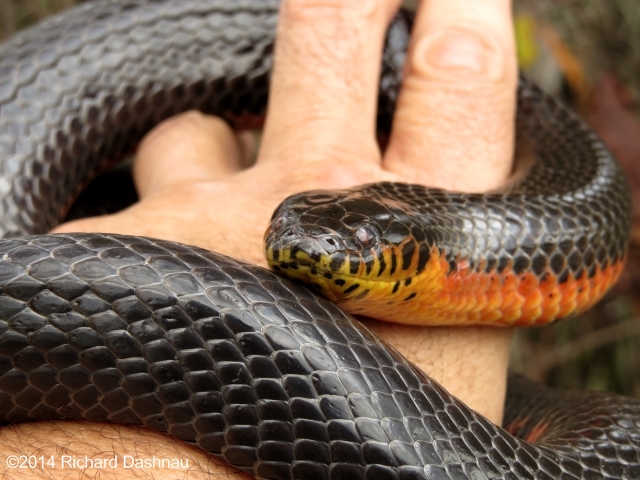
When I stopped, I looked back and down and noticed-curled up a couple feet
from the water-another snake.This one was a Cottonmouth. It didn't move
while I watched it, and I took some
pictures of the Cottonmouth. Then the Mud Snake started to move, so I took
a step closer to that. While I was watching the Mud Snake, I heard the
peep/splash of a frog hitting the water.
When I looked that way, I saw the Cottonmouth slowly moving towards the
water and moving under the leaf cover. Soon, I was alone with the
alligator again, so I moved on down the trail.
NOTE: I know the heading of this page is
"non-venomous 4", and the Cottonmouth is
venomous. But, it was next to the Mud Snake, so I left the stories
together.
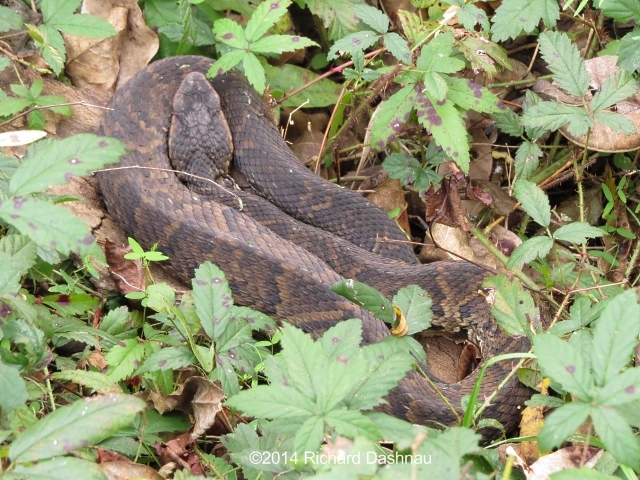
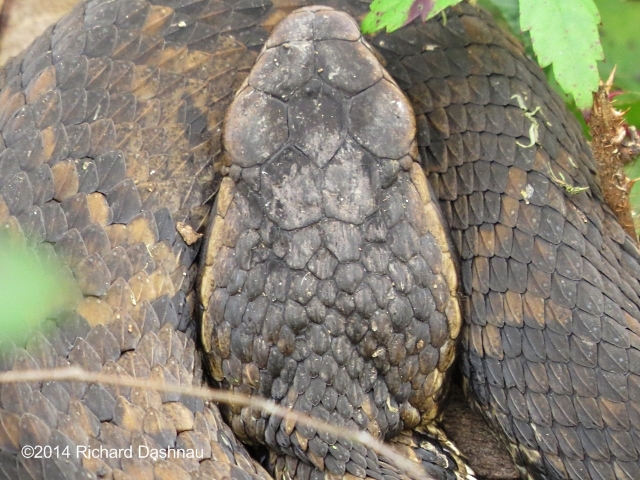
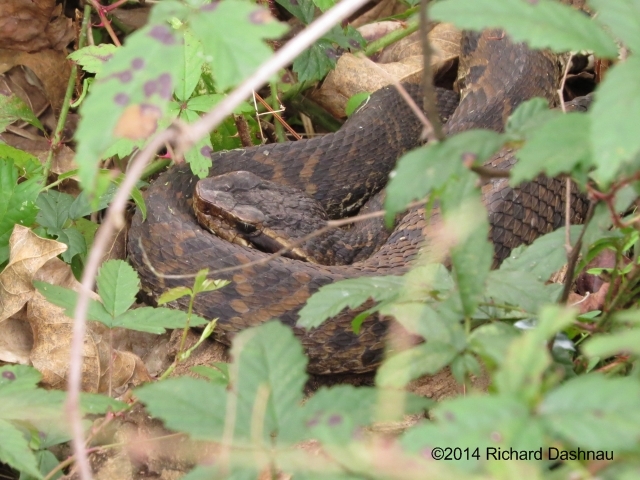
With the weather cooling that afternoon, I was probably watching two
methods of snakes thermoregulating. In the book "How Snakes Work" by
Harvey B. Lillywhite, there are examples of different
methods used by snakes to keep their Preferred Body Temperature (PBT) at
the correct level. Many snakes have a PBT of about 29-34 degrees C (page
109). This is 84.2 - 93.2 degrees F.
Sometimes a snake can use leaves as insulation. (p. 107) It appeared that
the Mud Snake was using the leaves. Meanwhile, the Cottonmouth was still
lying on top of the leaves, trying to get direct solar
energy. Also interesting is that the preferred body temperature of a
snake can vary with the season. That is, if the average daily temperature
changes to a different constant, then the snake's PTB
could shift with it; so that its body will work most efficiently at the "new" temperature. These
changes are produced by the snake altering its chemistry (by adjusting the
levels of various enzymes). Also,
these changes are reversable! This is called "acclimatization" when
it happens in the wild, or "acclimation" when inducedin a laboratory. (p.
110)
Gaining or losing heat by movement and use of external heat sources is
called "Behavioral Thermoregulation". (p.105)
Why do snakes
thermoregulate? According to the book, (p.113) 2 main reasons are:
1) to avoid extreme temperatures that would threaten their lives. For
instance, to avoid getting so cold that they cannot move enough to avoid
freezing.
2) to help their bodies function at peak efficiency. For example, for
proper digestion, or for coordinated nerve/muscle function during hunting.
11/30/2014--It was about 11:30am and I was walking on the
Spillway Trail just East of the Spillway Bridge. I was
talking to one of the Park Rangers who'd been doing bike
control.
As we were talking, with him standing and holding the bike, this
Rough Green Snake (Opheodrys aestivus) crawled out of the
grass on the North Side of the trail (the Pilant Slough
side).
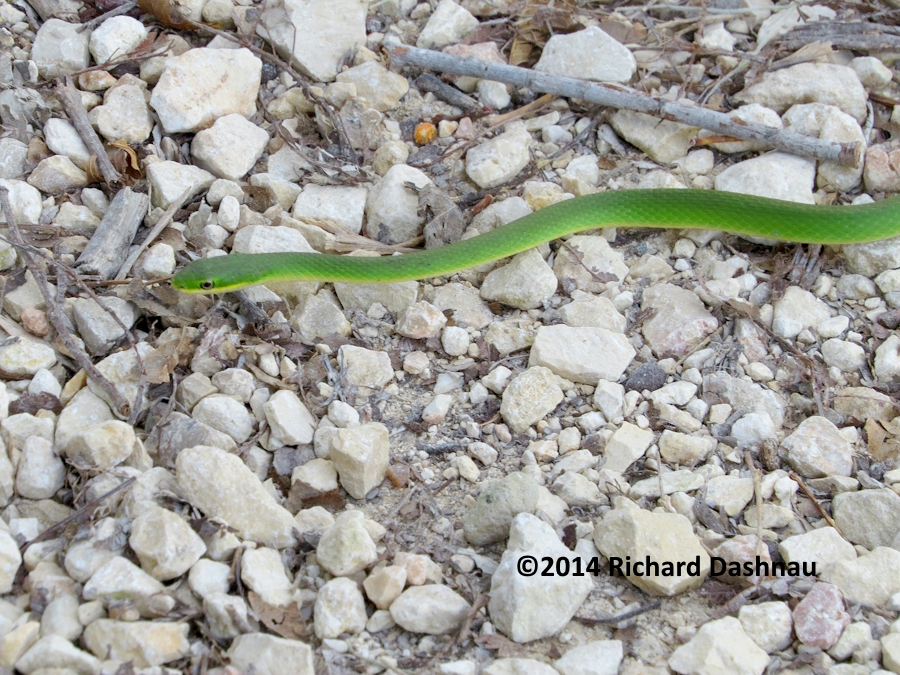
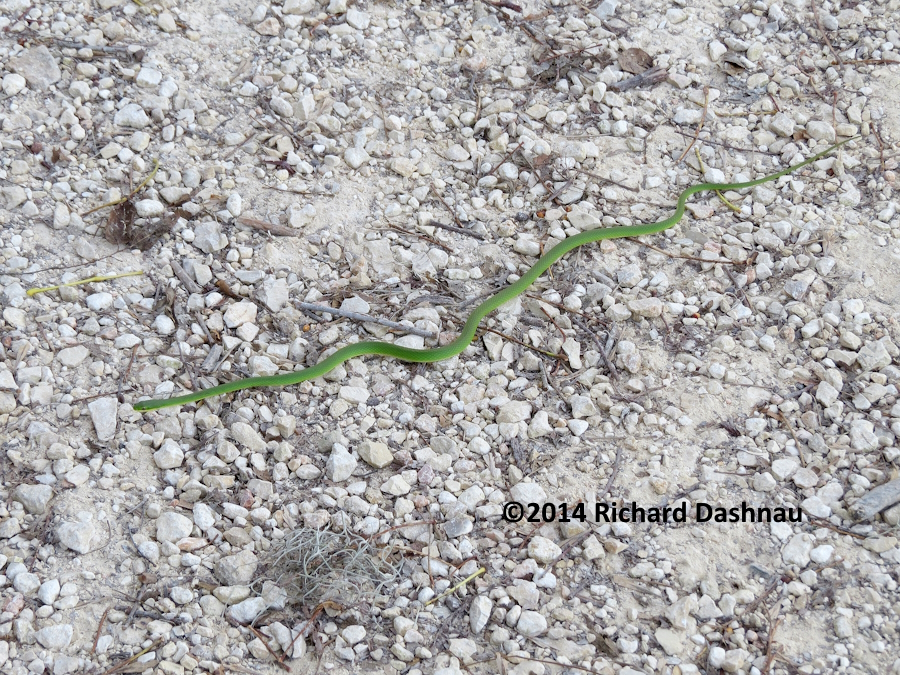
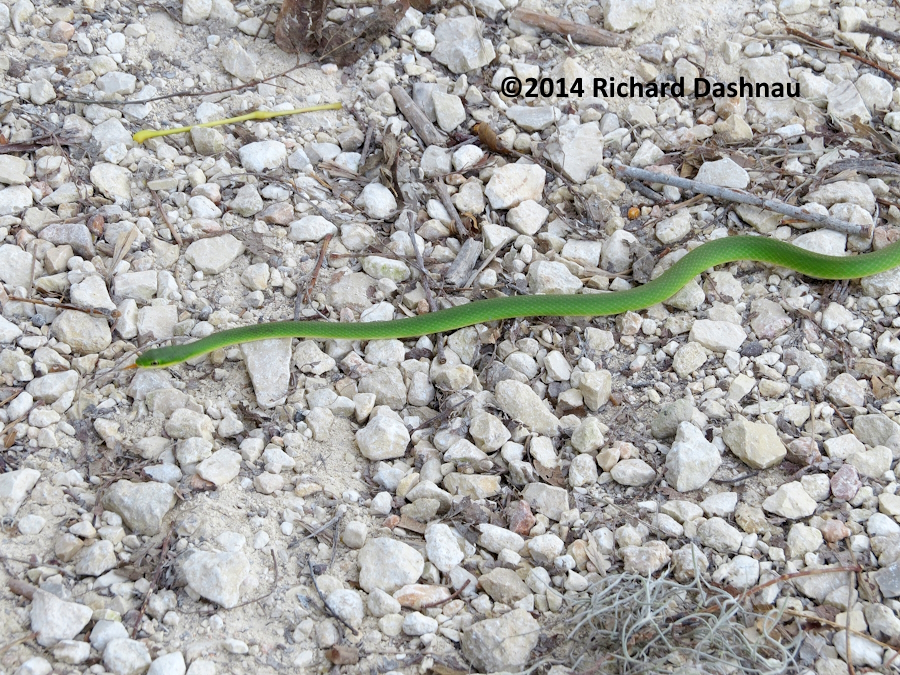
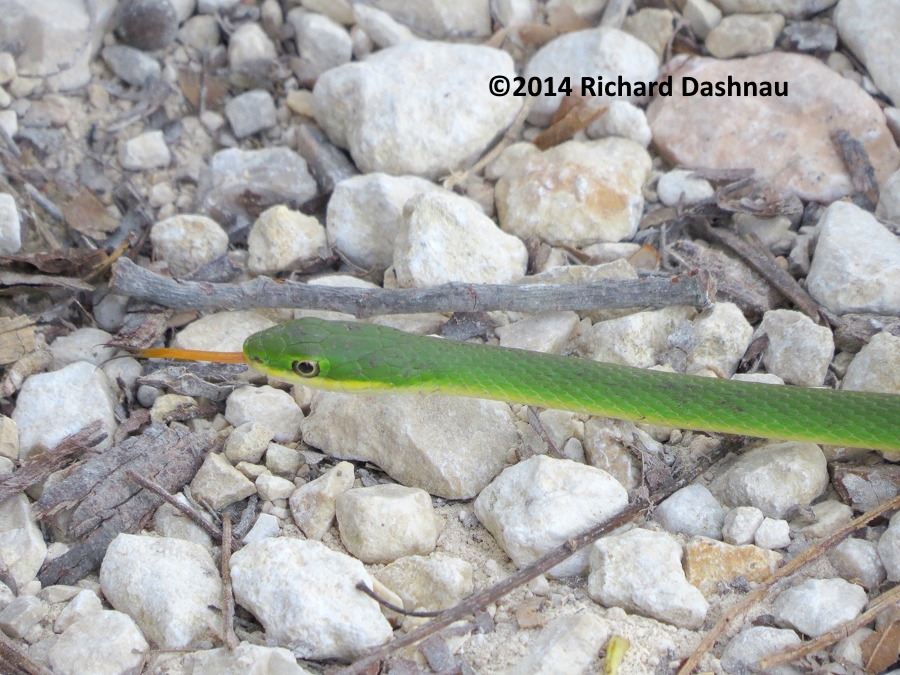
The situation became really interesting when
the snake--which was not moving very quickly, but seemed to
be tracking something-climbed onto the bicycle! Some of the
photos clearly
show the keeled scales which help distinguish this from a
Smooth Green Snake (Opheodrys vernalis).
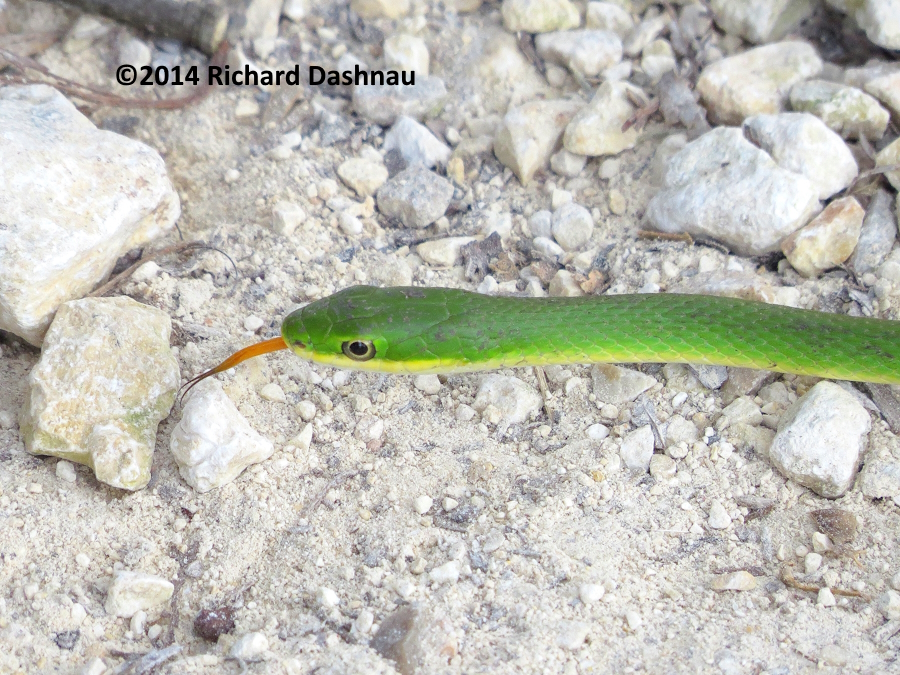
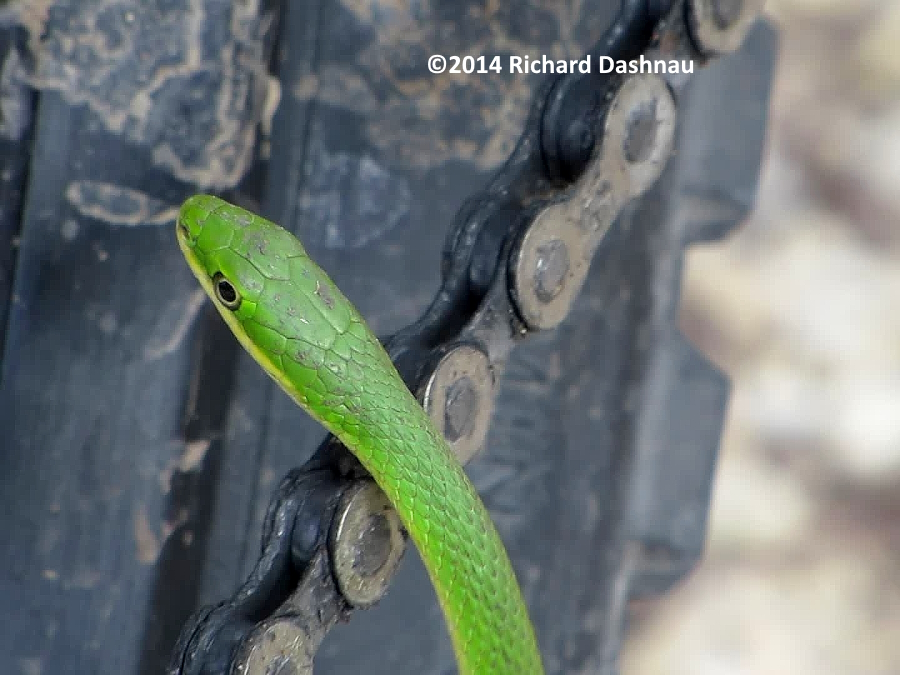
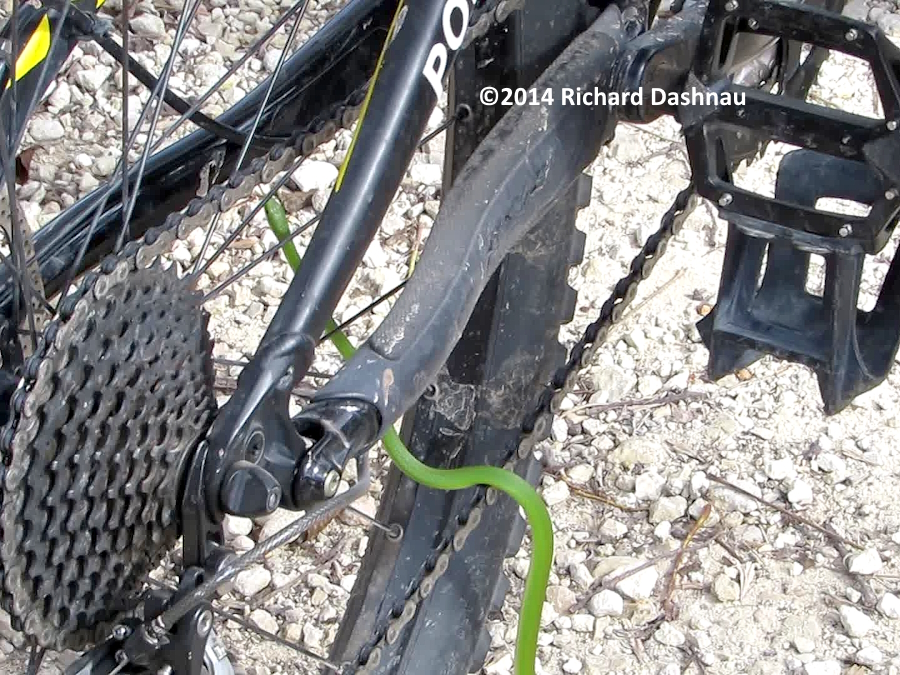
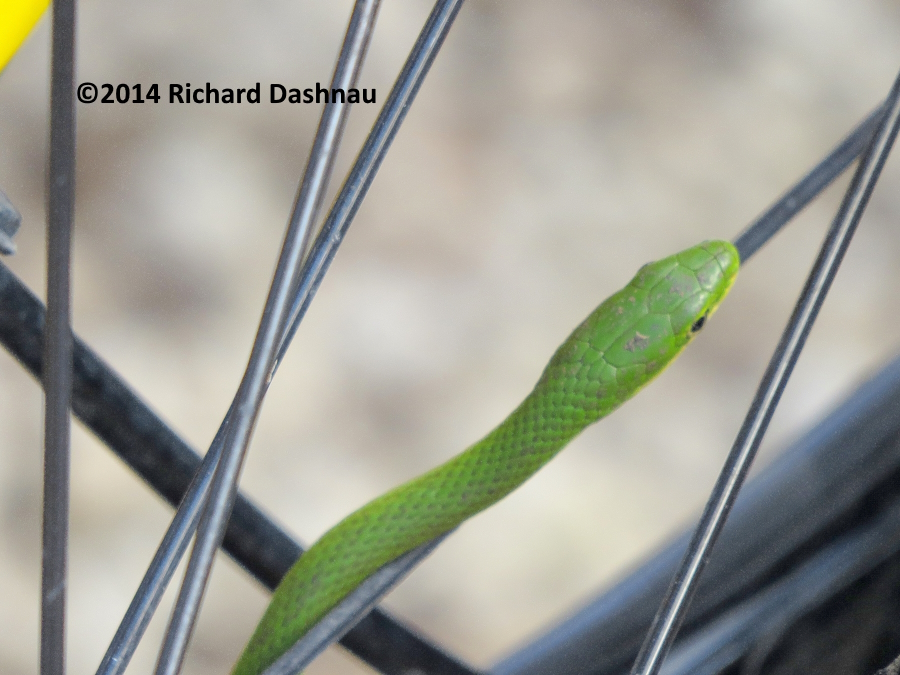
IThe snake didn't stay long, and crawled
back onto the trail, and back into cover.
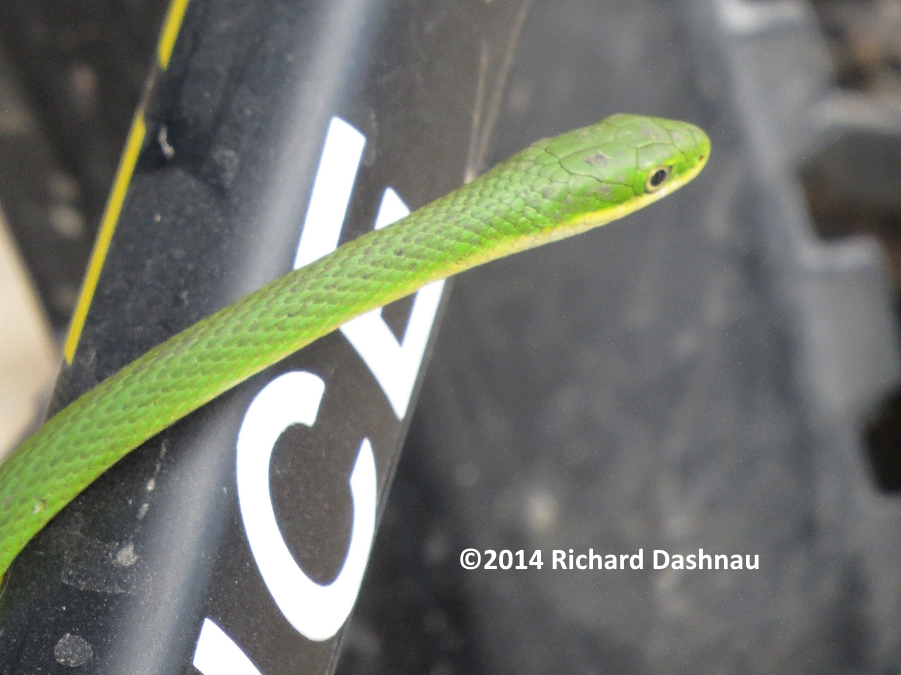
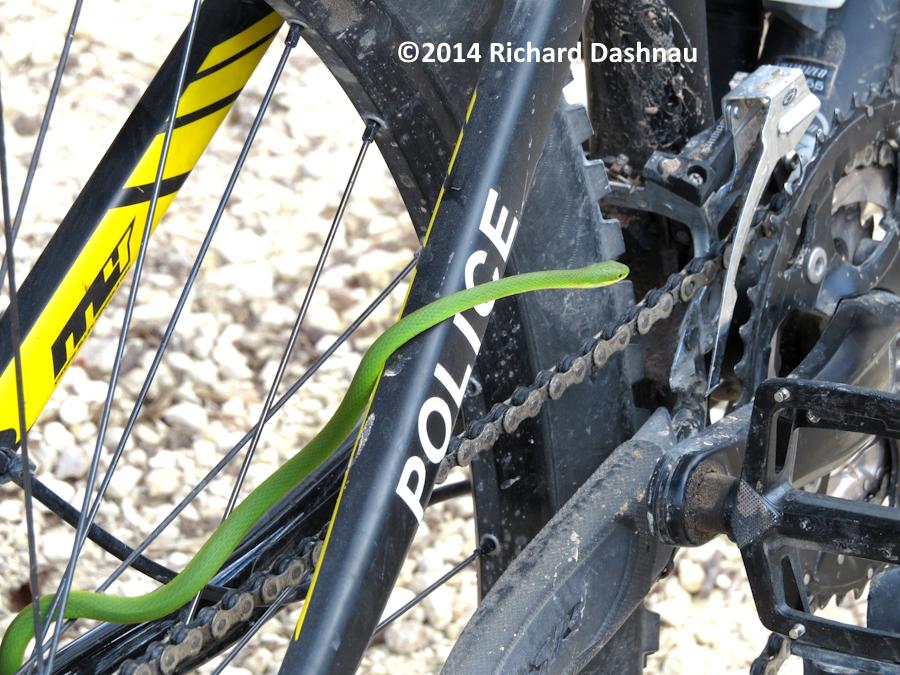
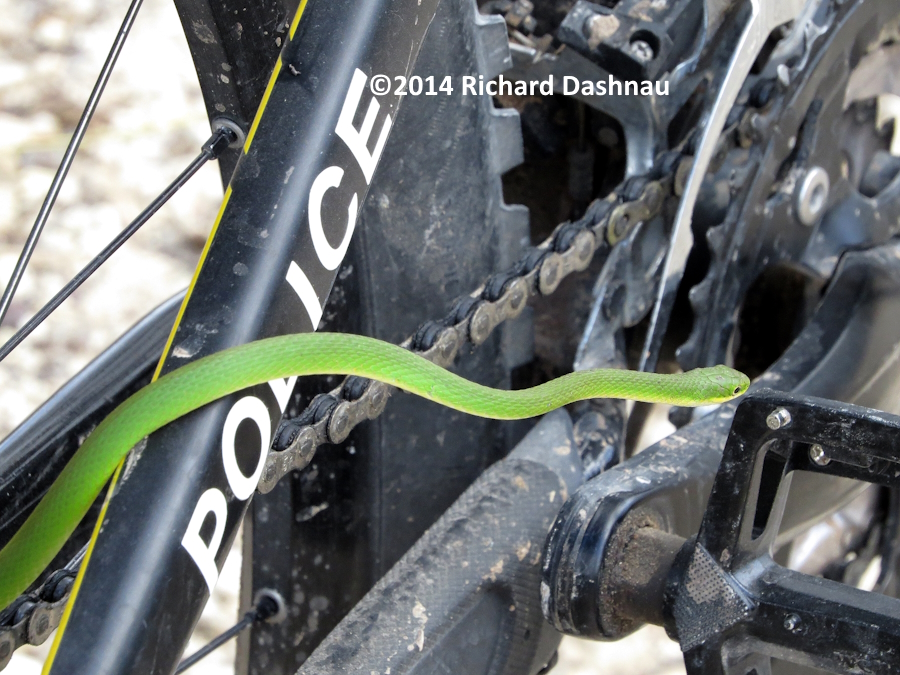
4/15/2012--It
was about 9:30am and I was walking down the Spillway Trail just
West of the Spillway Bridge when I noticed something odd in
one of the "duck nesting" boxes, about 20 yards away
from me. Something
was in the entry hole. It sure didn't look like a duck's head...or
anything I could easily recognise. A look through the binoculars
solved the mystery. It was a Texas Rat Snake
(Elaphe obsoleta
lindheimeri) relaxing in the opening! It looked as if it was
enjoying the morning, and watching the world go by. The snake
didn't move while I watched, and I finally left.
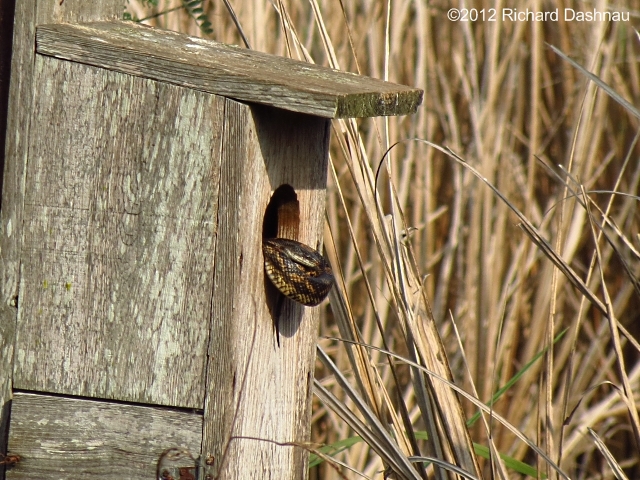
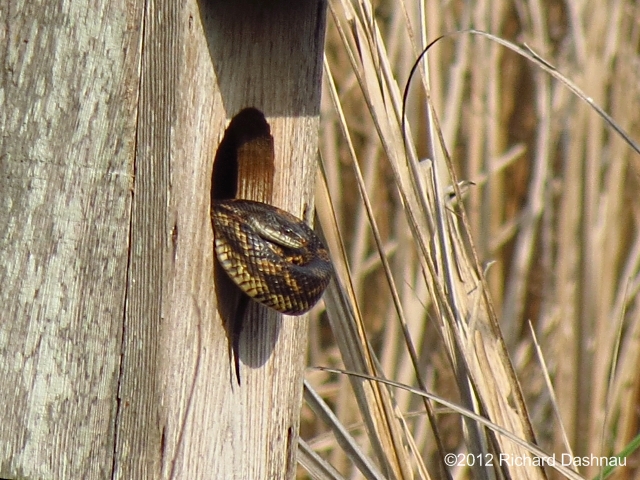
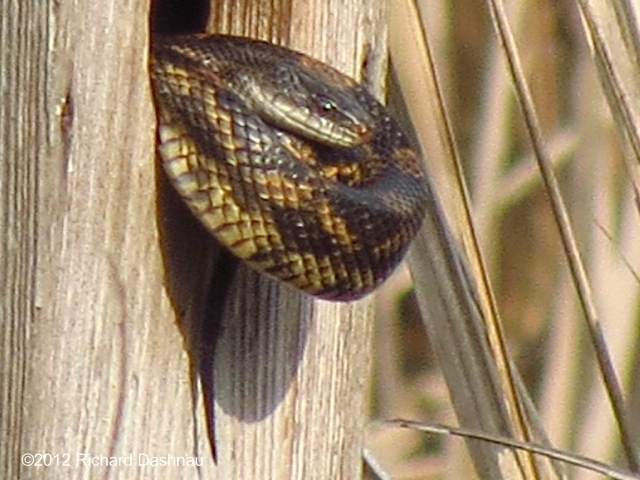
About 10 minutes
later, I saw this Gulf Coast Rbbon Snake (Thamnophis proximus
orarius) foraging near the trail. As it moved through the
undergrowth, it lifted its head straight up--a behavior
I call
"periscoping".--to see its surroundings. Sometimes, I just
get lucky. Two different snakes in 10 minutes!
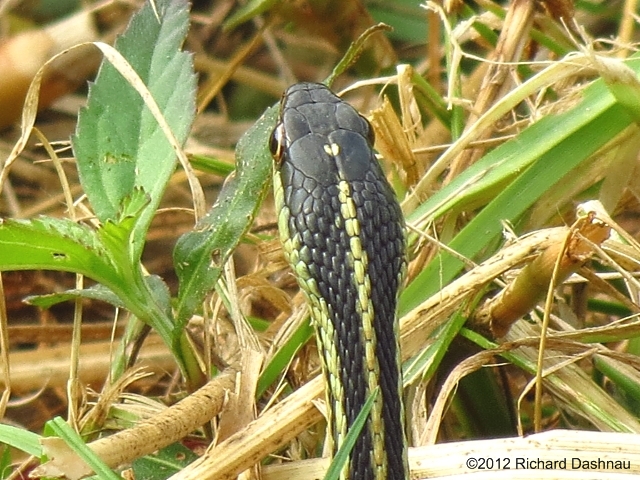
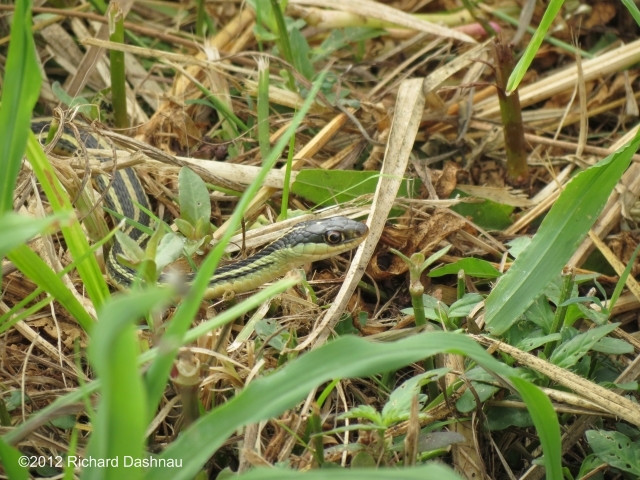
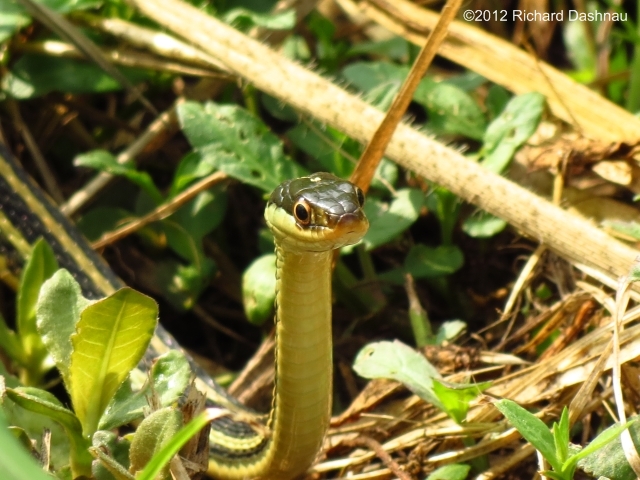
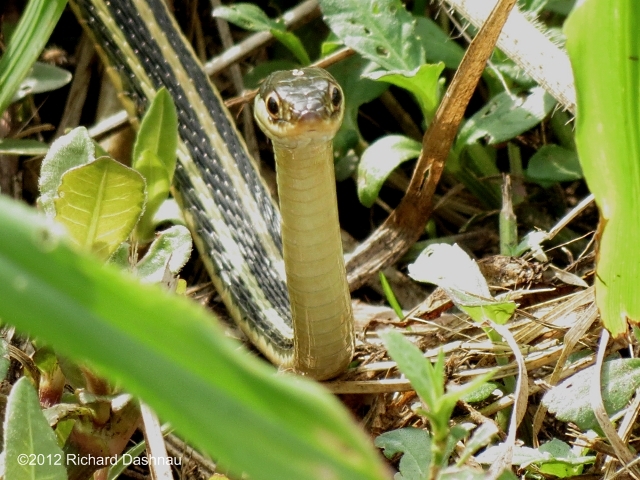
8/21/2011--I was walking on the West side of the Elm Lake
Trail when I noticed that high, long "chirp" that may mean that a
frog is being attacked. I moved slowly and carefully towards the
sound, and finally saw
movement in some grass. By using the high zoom on my camera, I was
able to get a few pictures of a snake just finishing the act of
eating a frog. One has to be quick
when locating the
frog making the sound, because the struggle sometimes ends
quickly. I think the snake is a Gulf Coast Ribbon snake
(Thamnophis proximus orarius). The 3 scales at the
tip of the snout
appear to be tan-colored, and there are two yellow scales (2
spots) at the center of the top of the head. The frog is
probably a Southern Leopard Frog (Rana Sphenocephalia),
but I only saw part
of its head.
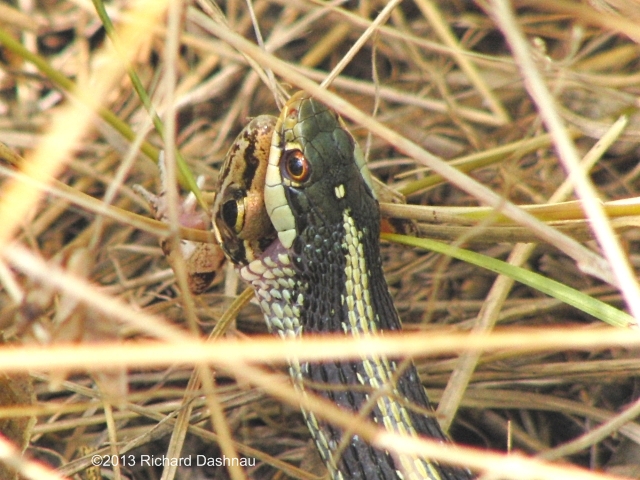
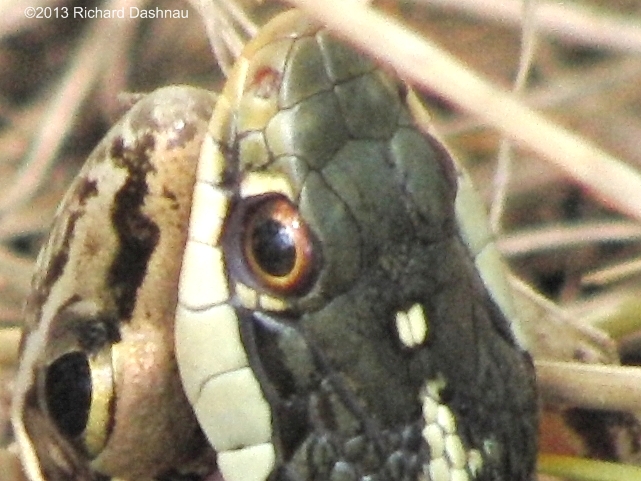
11/14/2010--At about 8:45 AM, I was walking on the West end of
the Spillway trail when I noticed this Western Mud Snake (Farancia abacura reinwardti)
next to the trail. The air was a bit cool
(I was dressed in warm
clothes) so the snake was quite sluggish. I carefully picked it up
and was happy to see that it was alive and unharmed. As I held it,
it coiled into a ball, possibly for defense.
I took some
pictures, but couldn't get a good look at its tail. I've got more
information, and pictures of a young Mud Snake, on one
of my other web pages (look for the date March 29, 2006).
After I took my pictures,
I placed the snake back in the grass along the trail.
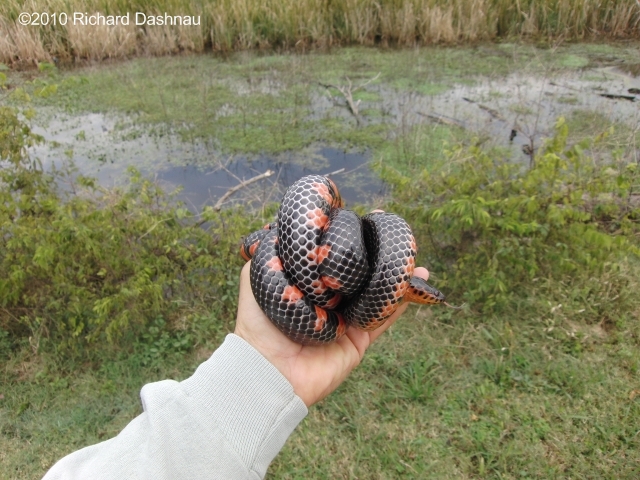
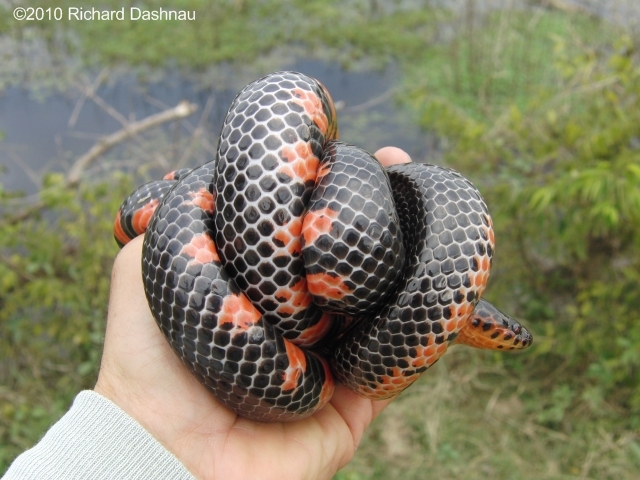
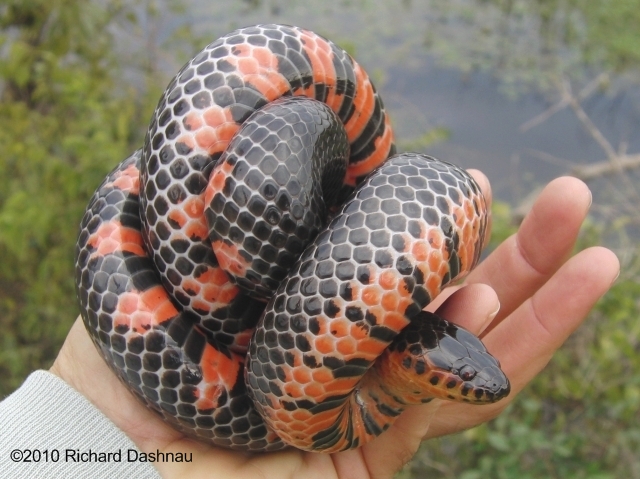
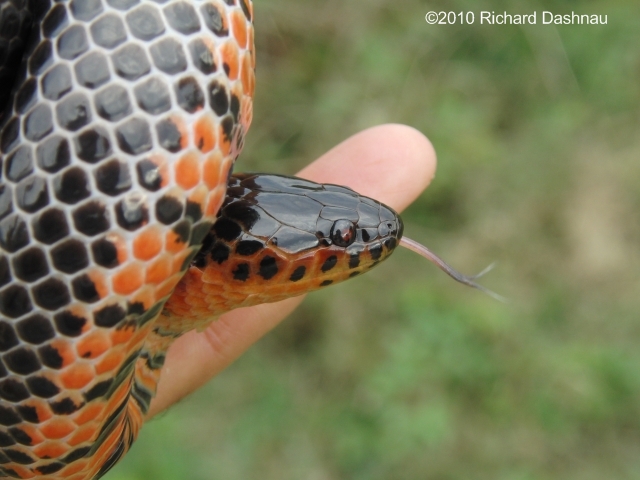
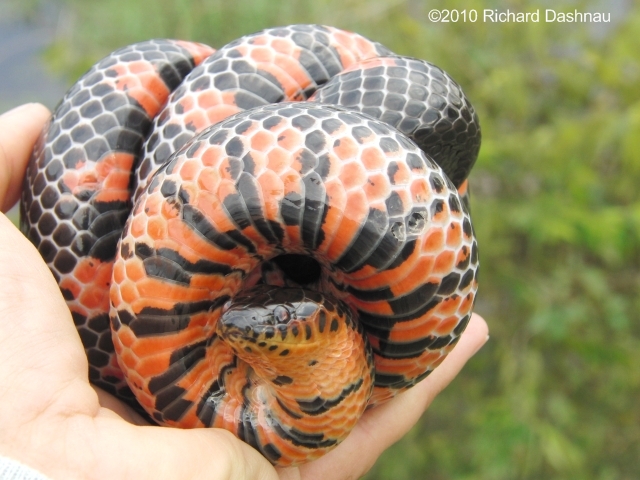
4/29/2007--An
Eastern Coachwhip snake (Masticophis flagellum) was found in the
woodyard at Brazos Bend State Park. It was caught, brought to the
Visitor's Center, where I was able to
get some pictures. I also used
it for a snake program, and it behaved very well for a newly-caught
snake. I've read some accounts that describe how they will
energetically defend themselves,
but this snake was quite
docile. It's called a "Coachwhip" because the coloration and the
scales as they near the tail give the snake the appearance of a
braided whip. The snake hunts
many kinds of small
prey--including lizards, snakes, mice and birds--and will also eat
eggs. It is described as an excellent climber.
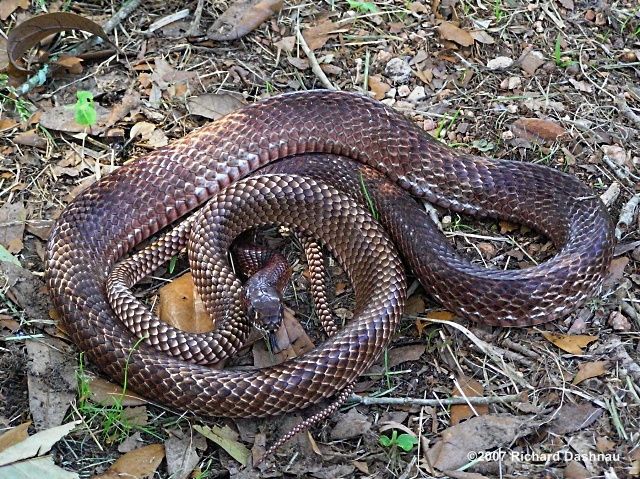
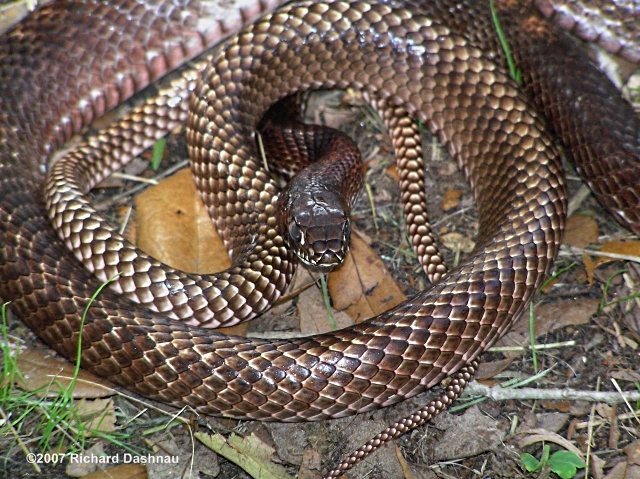
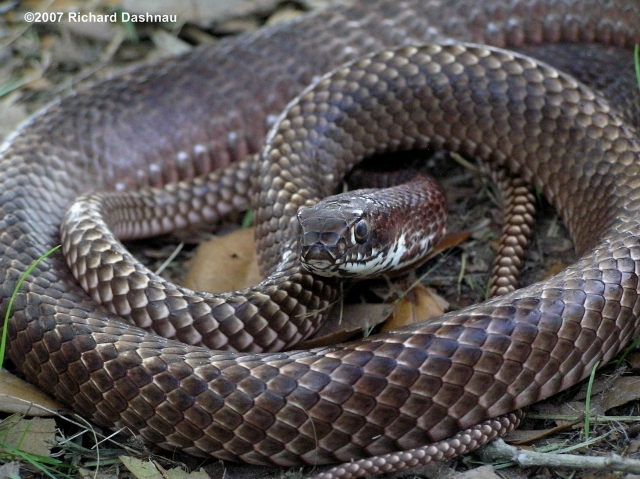
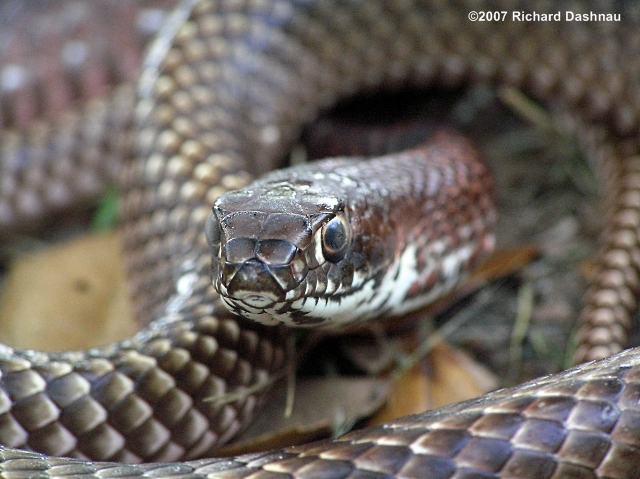
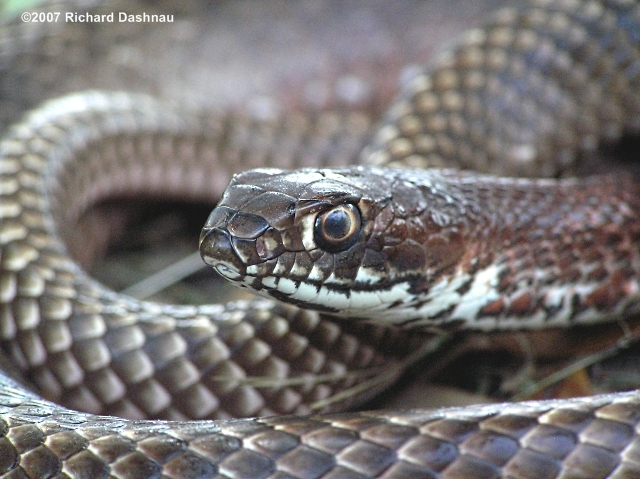
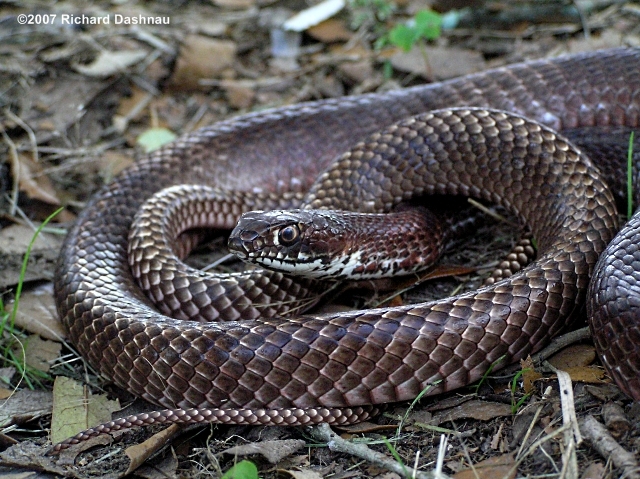

4/23/2006--I was walking down the Spillway Trail, not far from
the Observation Tower, when a sound--among all the other sounds of
the park--finally worked to the front of my consciousness.
It was a strange sound,
a sort of long, drawn-out, low chirp. As I listened, I thought of a
small bird in distress. I started scanning the trees in front of me,
and finally, I caught a glimpse of what
was making the sound.
It wasn't a small bird. It
was a small frog! A Green Tree Frog (hyla cinerea), and it
had been caught by a Ribbon Snake (thamnophis proximus). It
was really difficult to see amongst the leaves,
and the tree swaying in the gusts of wind didn't help. I finally
found the snake with the viewfinder of my camera, and snapped one
picture. Then, I set up the video camera, found the snake with
that, and left it on the tripod to film while I tried to take some
more still images. Unfortunately, with the teleconverter and the
movement, I had a really hard time finding the snake again, and
only
shot one more still image. I did get more with the video camera, though.
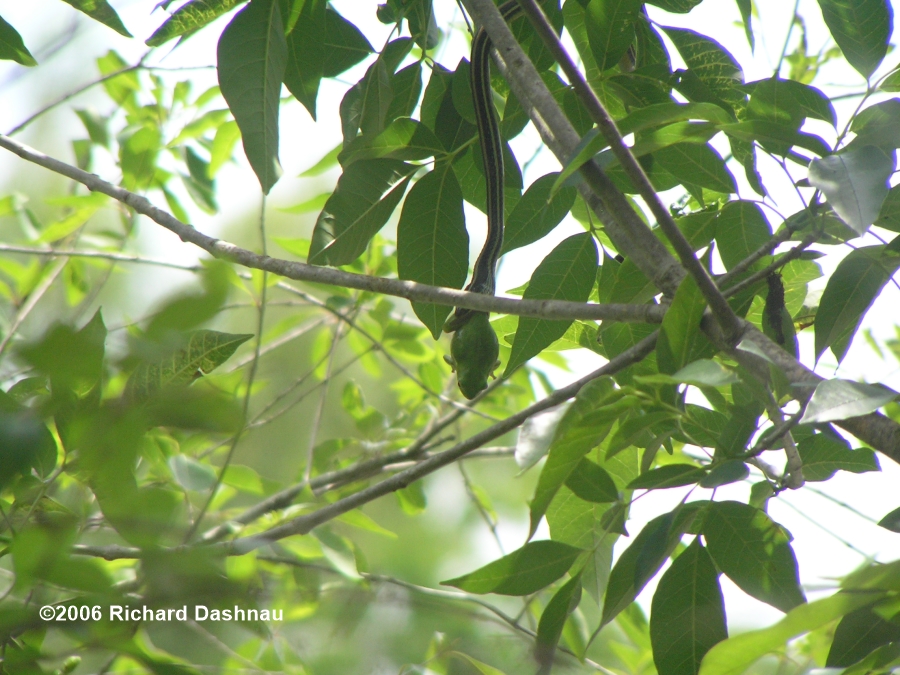 -
-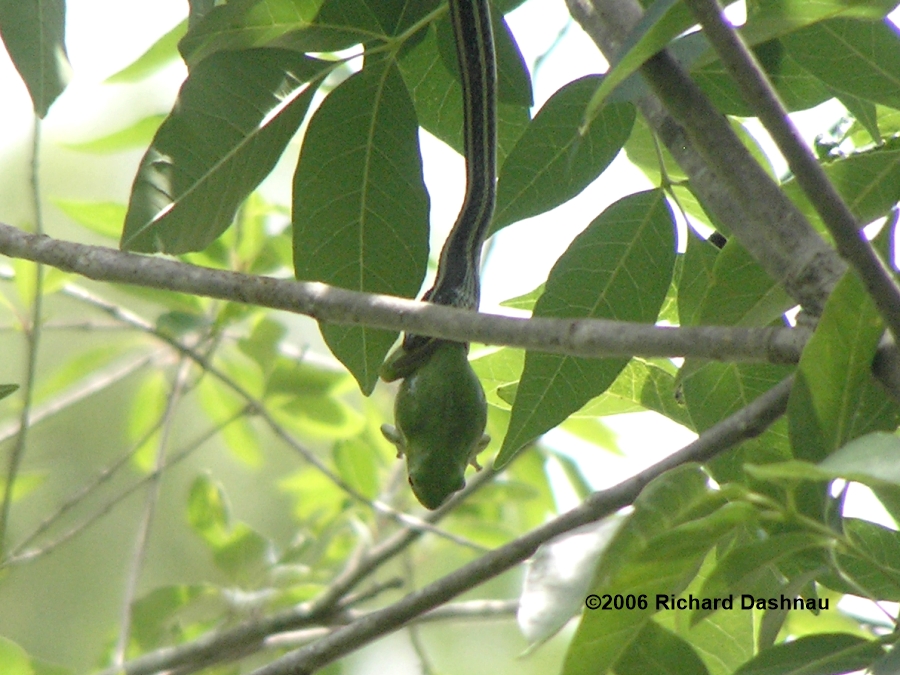 -
-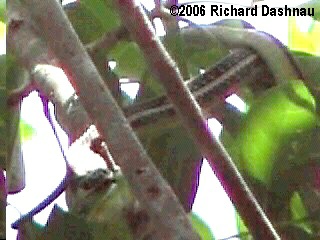 -
-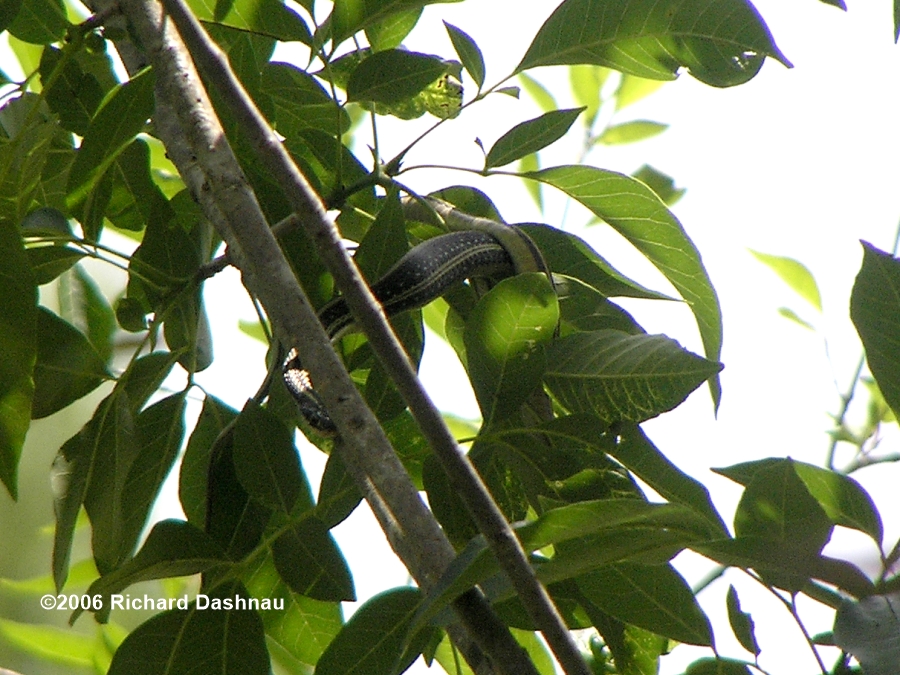
PECULIAR
FRUIT
BETTER
CLOSEUP VIEW
EATING WITHOUT
LIMBS
COMPLETED MEAL
I did get more with the
video camera, though. The first two images above (PECULIAR,
CLOSEUP) are from the first still image, cropped and resized. I've
read in many places that snakes
usually eat their prey headfirst, to allow for easier folding of
the limbs as it is swallowed. This frog is going in rear legs
first. Consider the amazing feat of catching and eating this
meal---without
any limbs! The snake had to climb the tree, stalk the frog and
then catch it. Then, with the frog still very much alive, the
snake has to manipulate the frog down its throat AND STILL
HOLD
ONTO THE TREE--all without the aid of any limbs. The snake used a
combination of specialized muscles and scales to climb the tree
and hold itself in place. The frog is trapped, and
manipulated by extremely sharp teeth. Each of these teeth are
curves so their points are towards the snake's throat. Moving away
from the throat causes the points to dig in, and the teeth to
hold. The only way to easily get free of the teeth is to move down
the throat. The process is helped by the snake's full control over
the actual shape of its jaws. Each side can move independently
to work alternatively to pull in, or to grab. The third image
above (WITHOUT LIMBS) is a frame from a short clip (
SNAKE w FROG mp4) that shows some of this action. The clip is edited
from much longer footage to remove the swaying of the tree and to
shorten the clip. I've also cropped it from the full-frame clip.
The last image above (COMPLETED MEAL) shows the snake
resting after its meal. It's the only other picture I was
able to take. I've
heard the occasional cry of a frog being eaten, and sometimes I've
found the frog in the clutches of a snake---sometimes I
never find it. I wonder why frogs make this sound. It's
unique, and once heard, is not easily forgotten. It just sometimes
blends in with the various other cries and calls from birds and
insects, so
I don't notice it. Is this a reflex? Is the intent to call
attention to the frog, and the snake, so a predator may appear and
attack the snake? Is it to warn other frogs? I understand they are
not social,
but this kind of programming would serve to minimize damage of the
frogs in a particular location by a hunting snake.
Snakes page 1 nonvenomous 2001 -2002 Snakes page 6 Rat Snakes 2002 - 2021
Snakes page 2 nonvenomous 2003 -2004 Snakes page 7 venomous 2002 -2021
Snakes page 3 nonvenomous 2004 -2006
Snakes page 5 nonvenomous 2022
-2023
Go
back to my home page, Welcome to
rickubis.com
Go
back to the RICKUBISCAM
page.



















































































 -
- -
- -
-